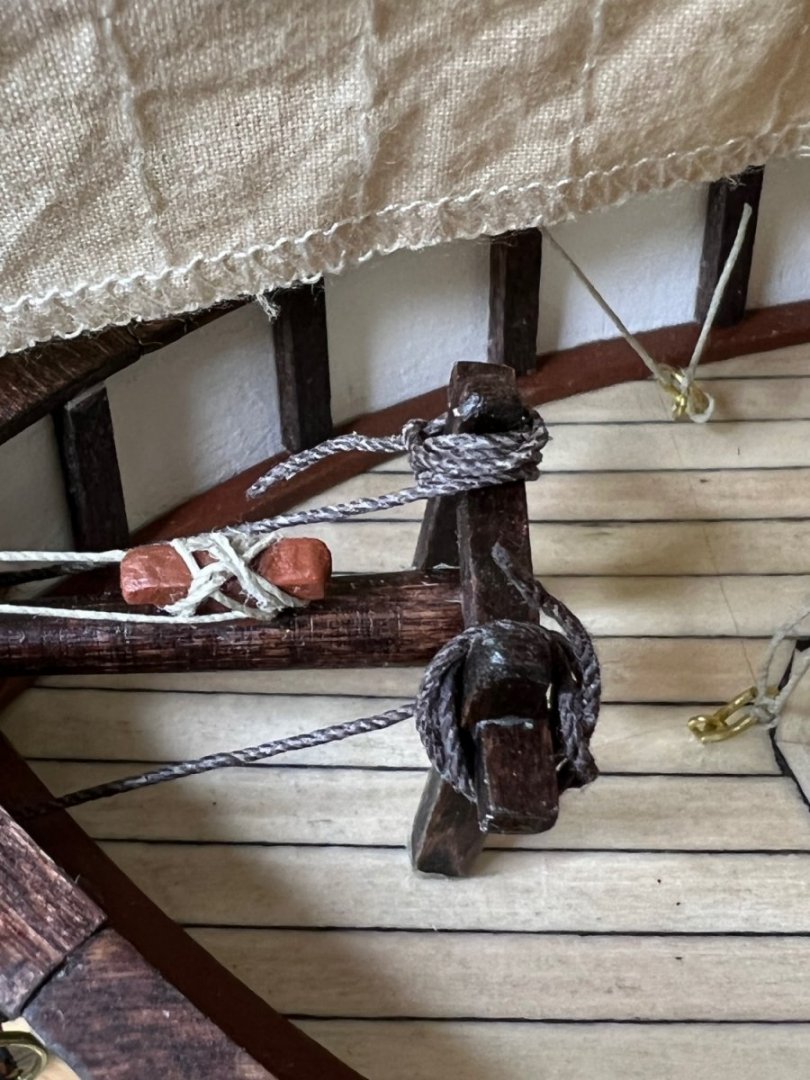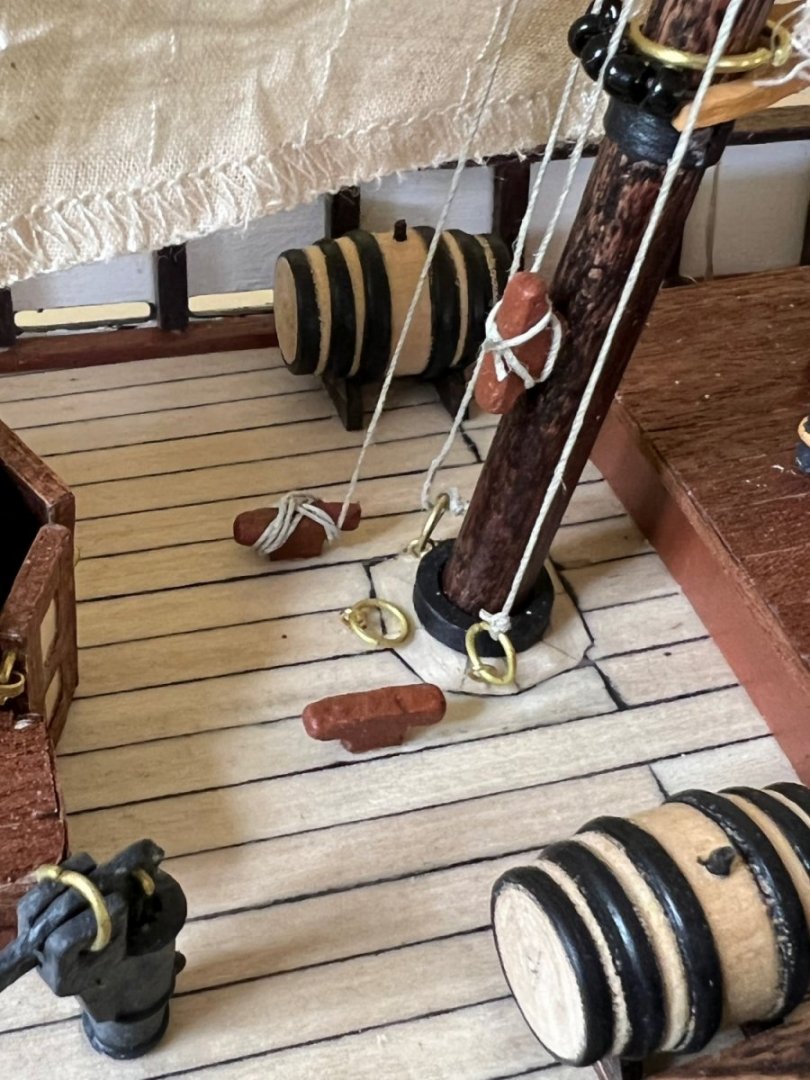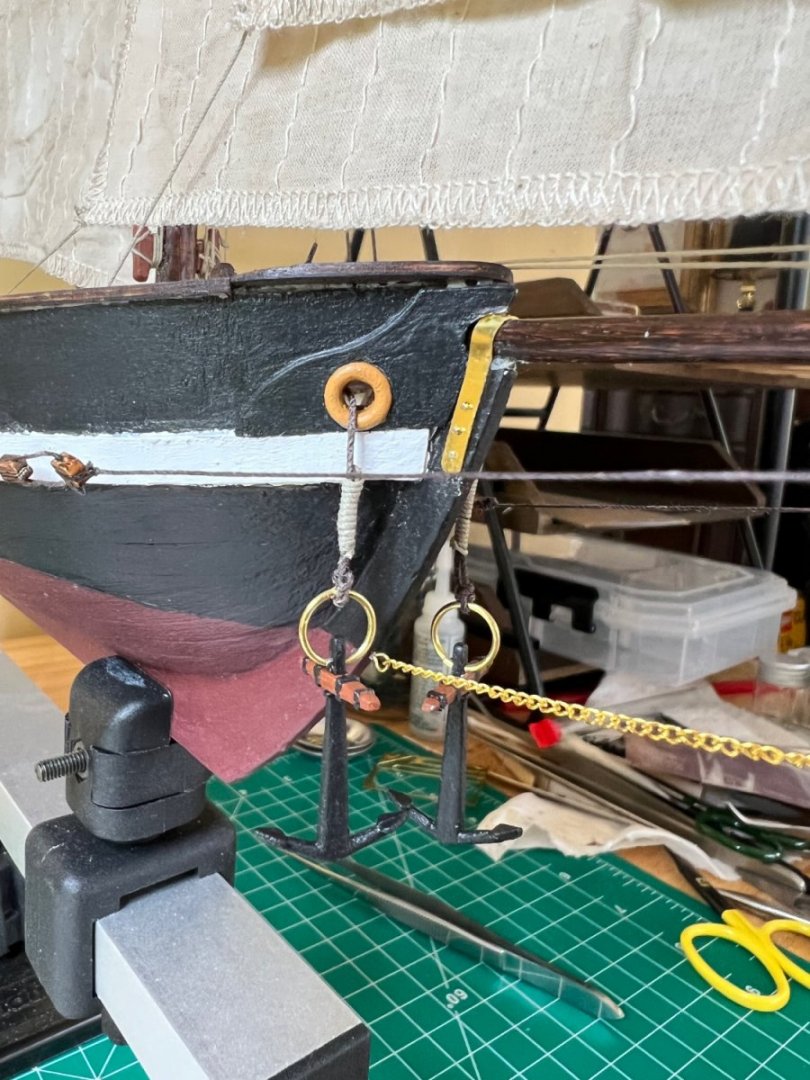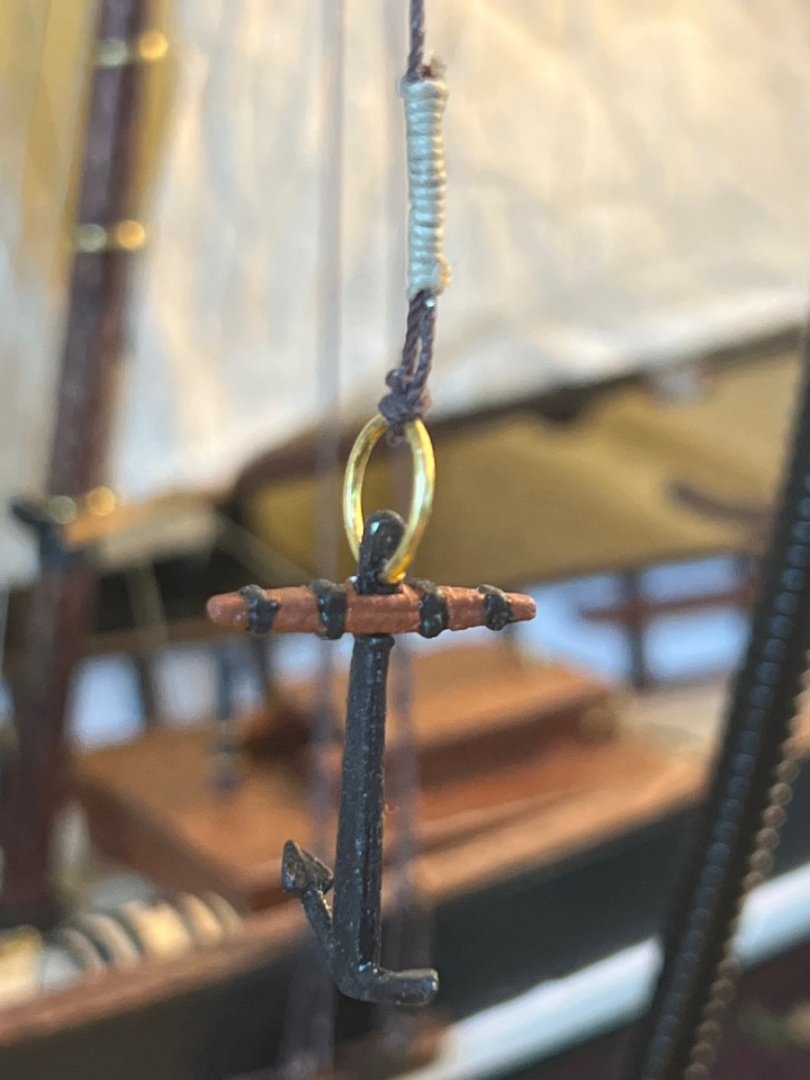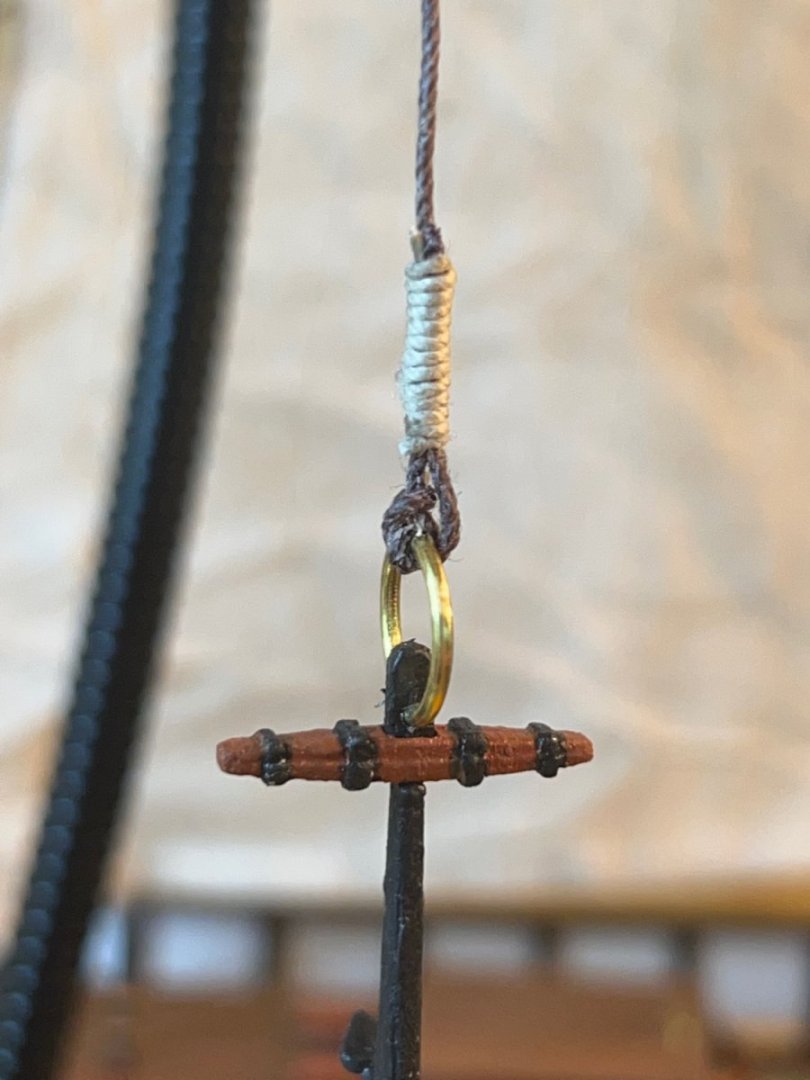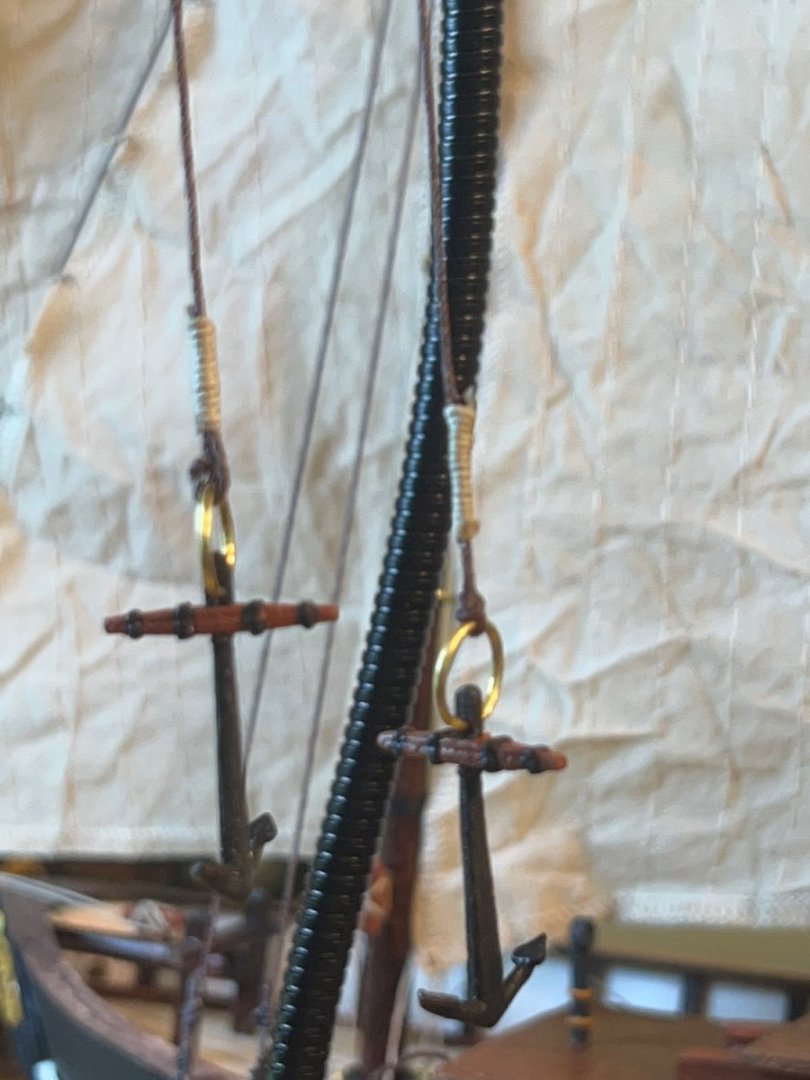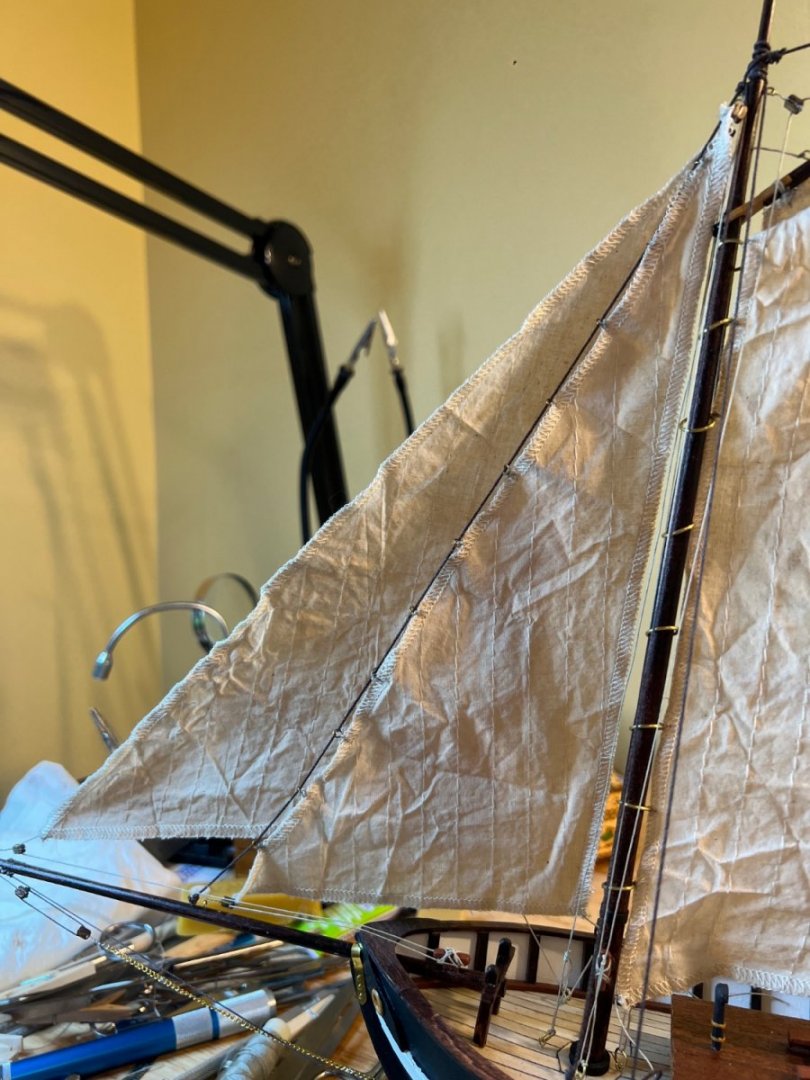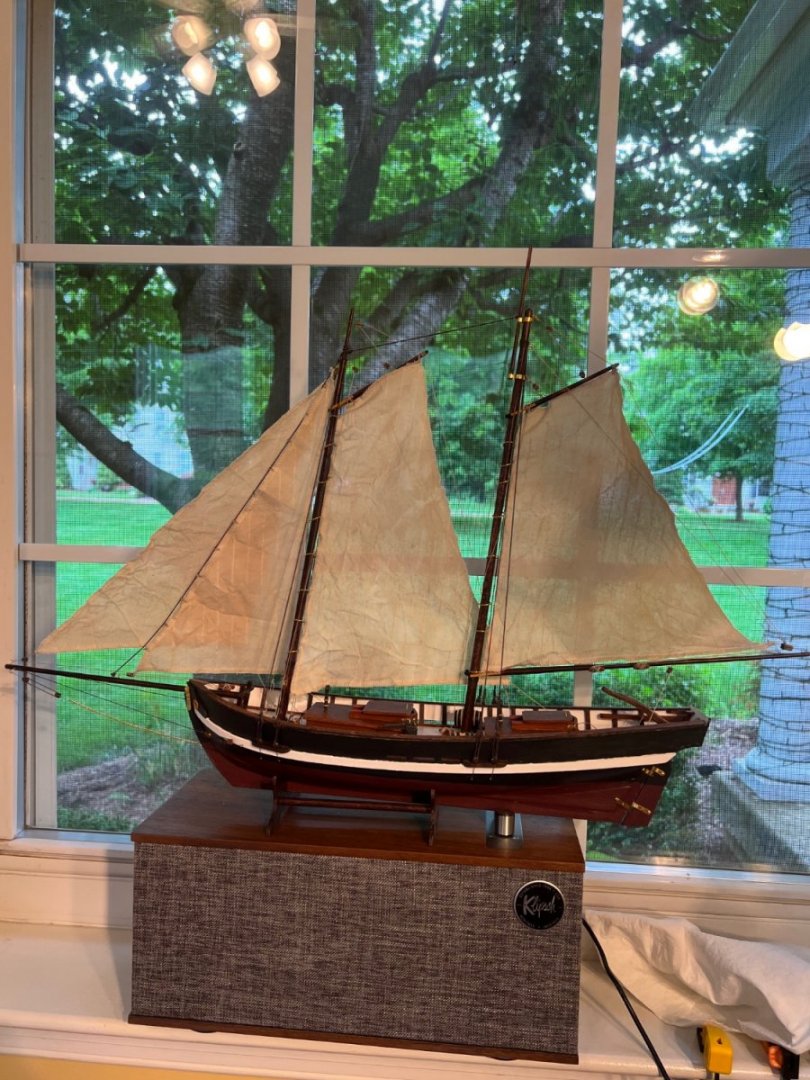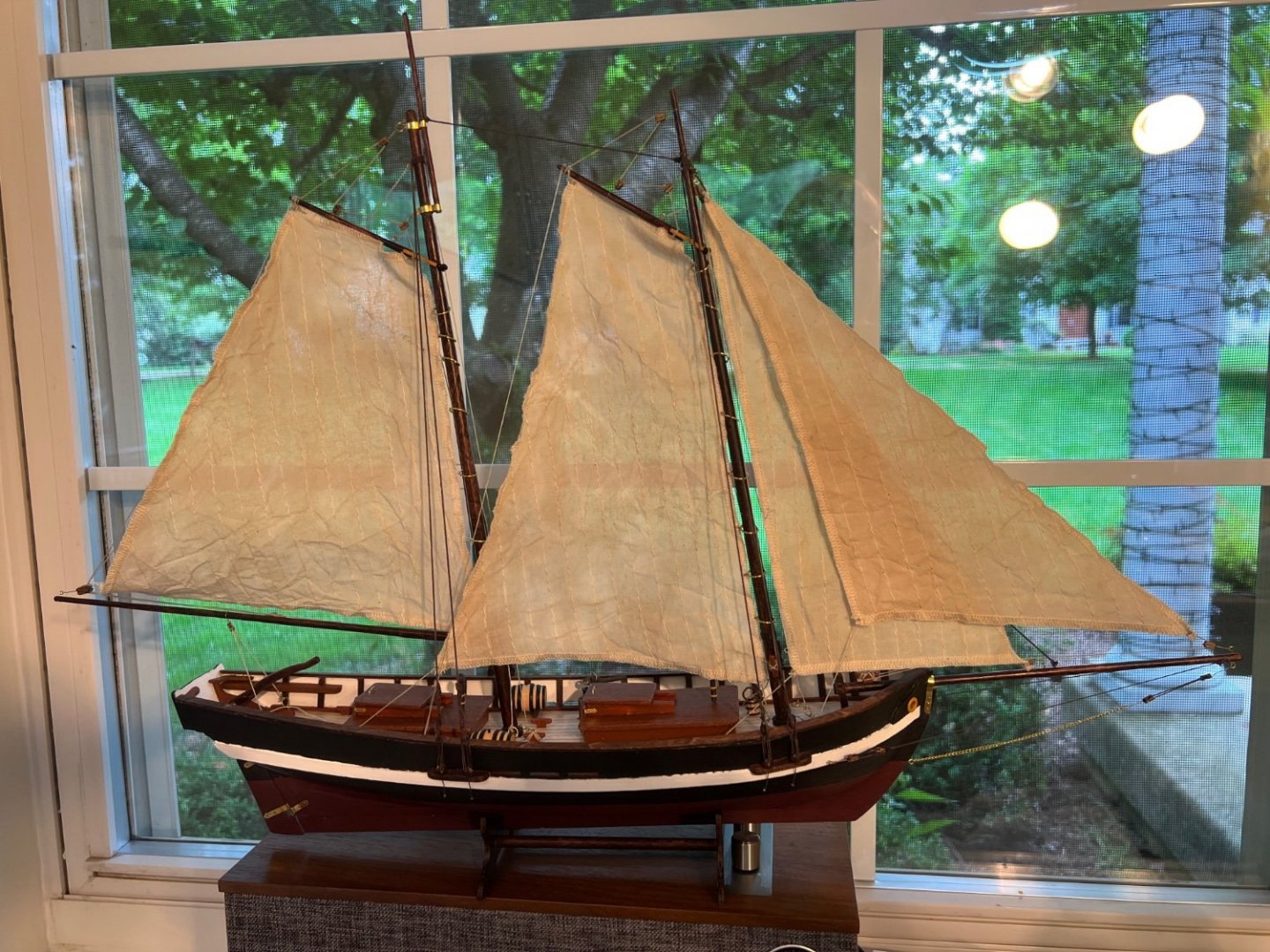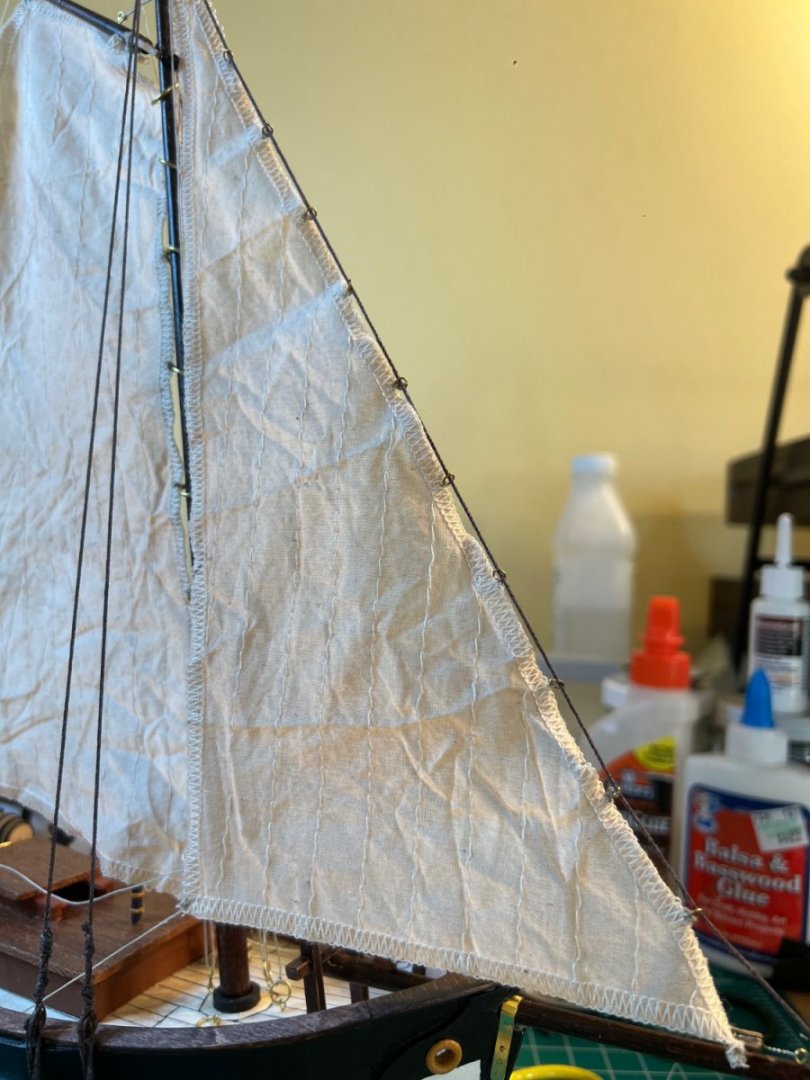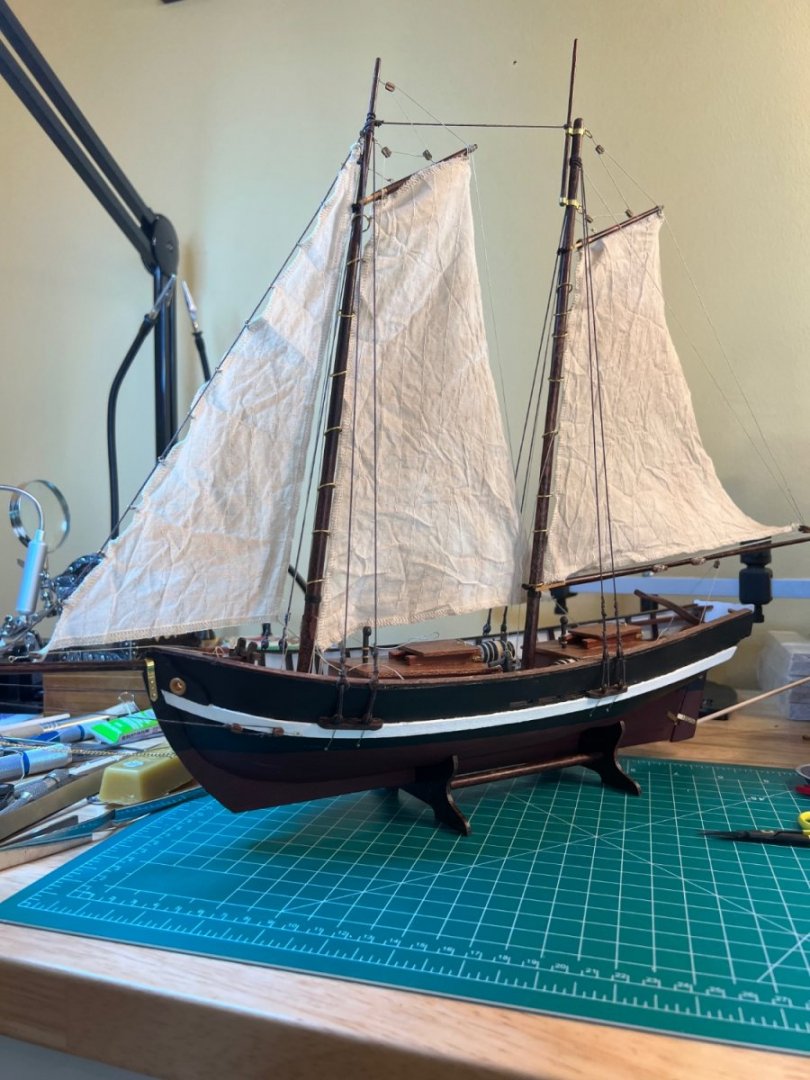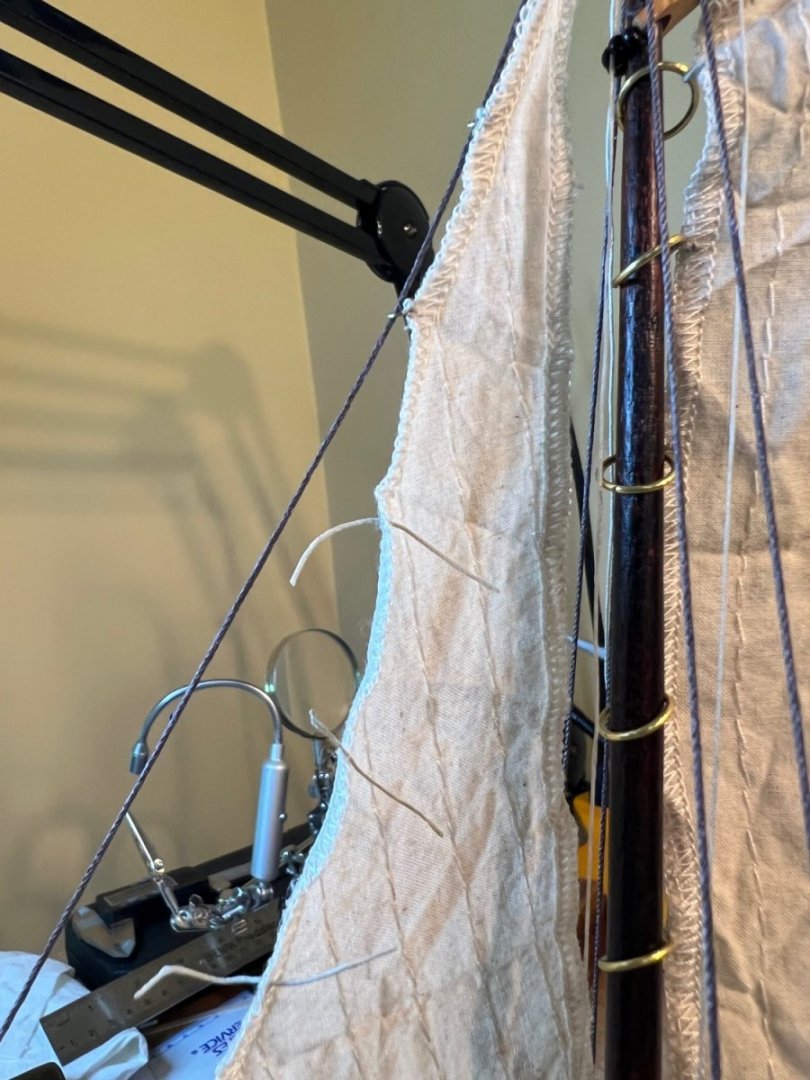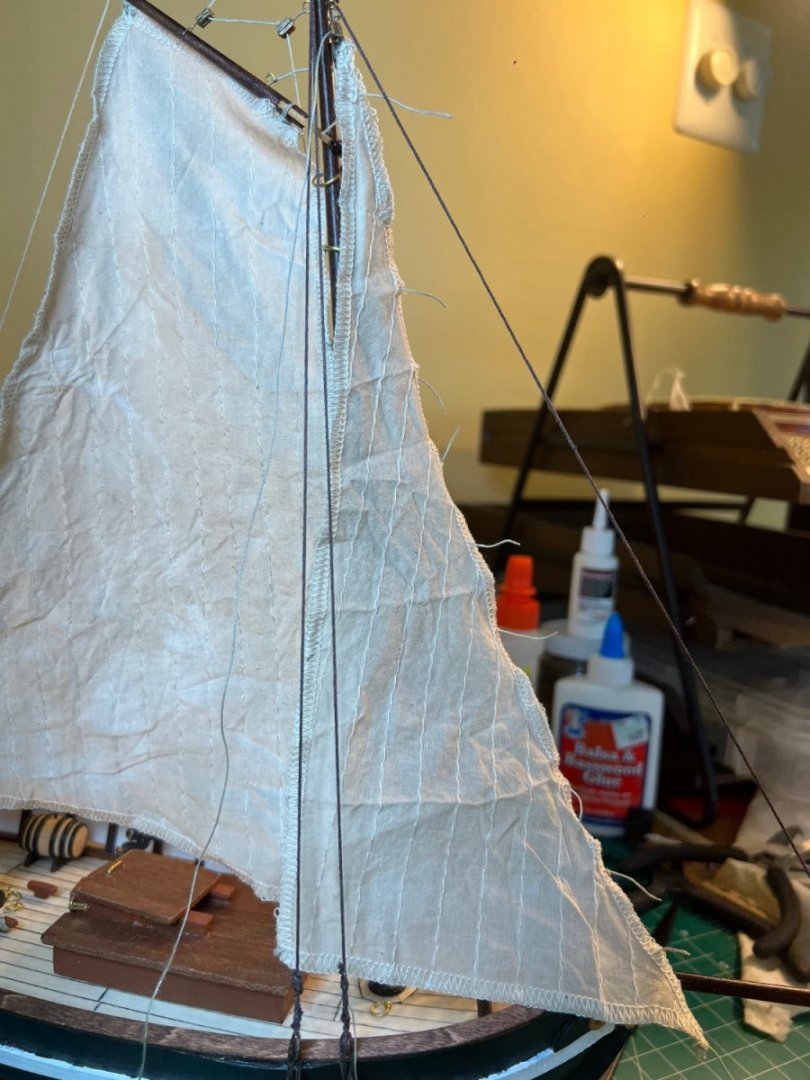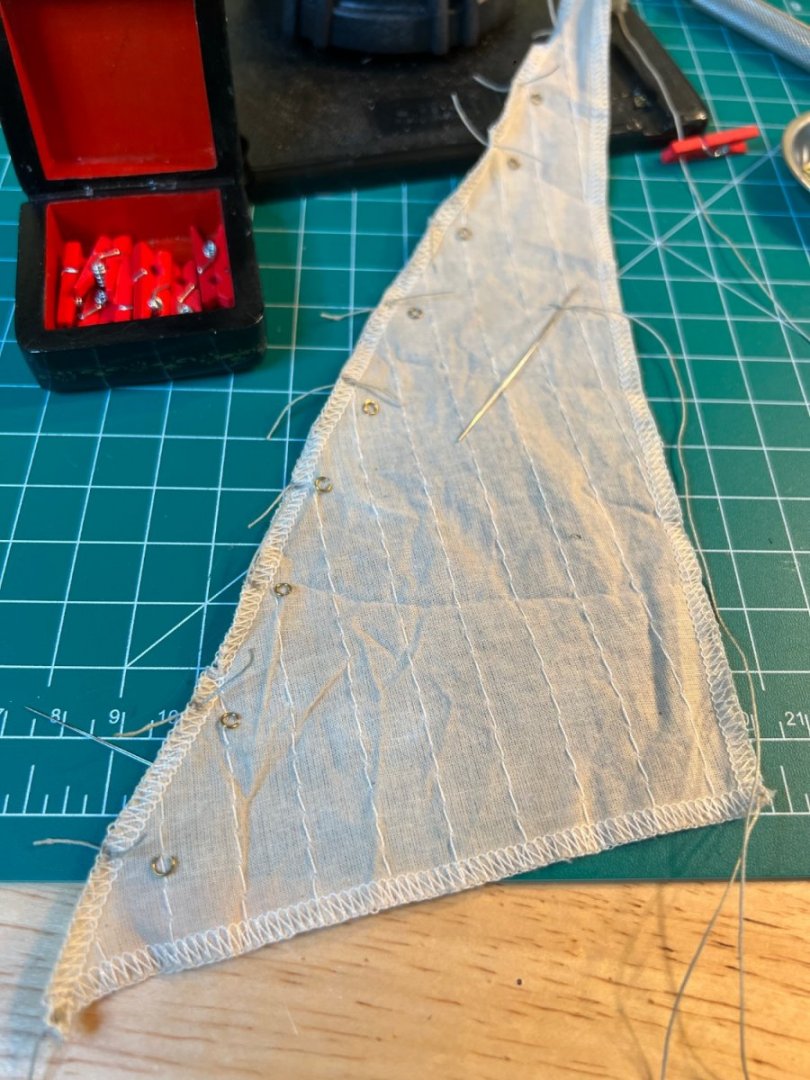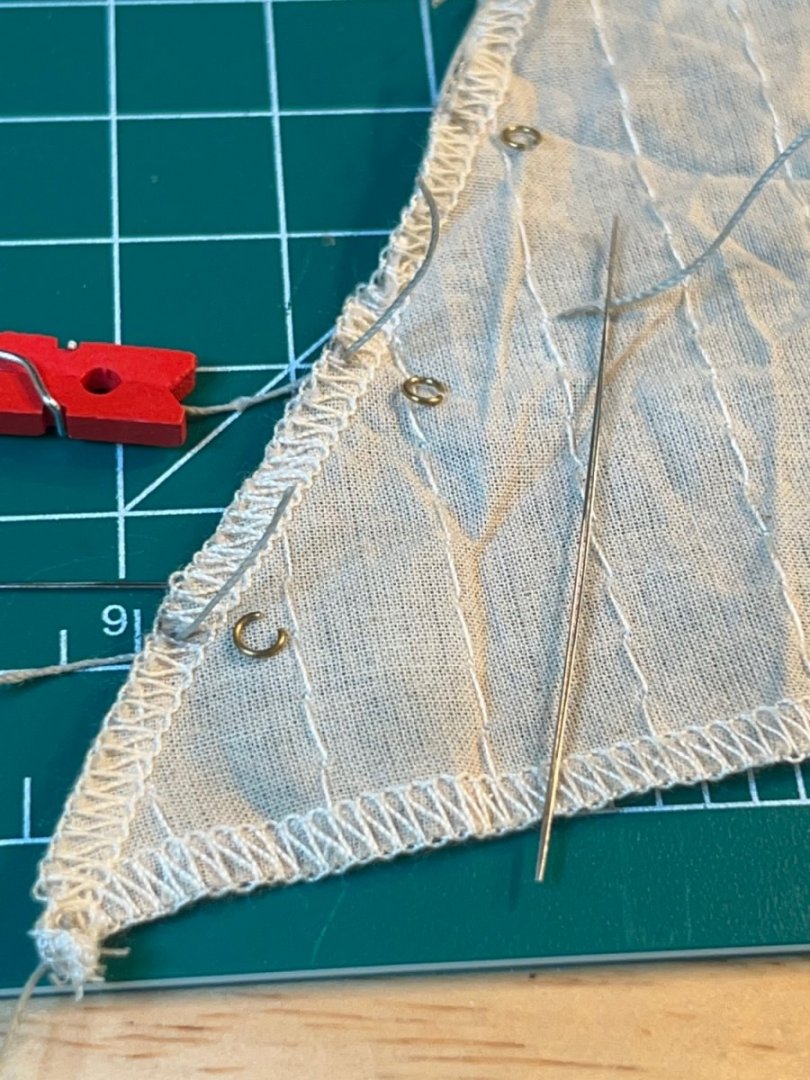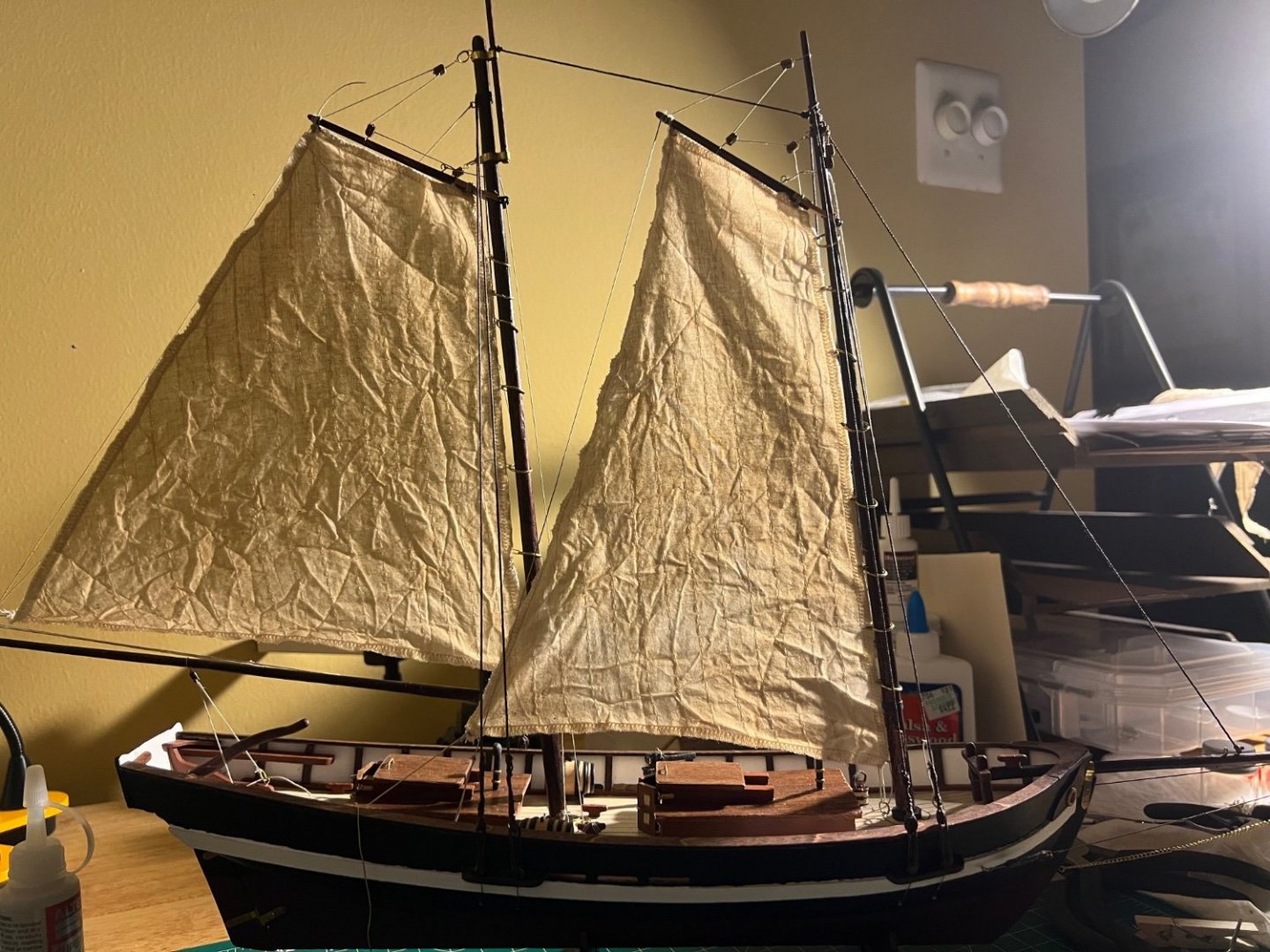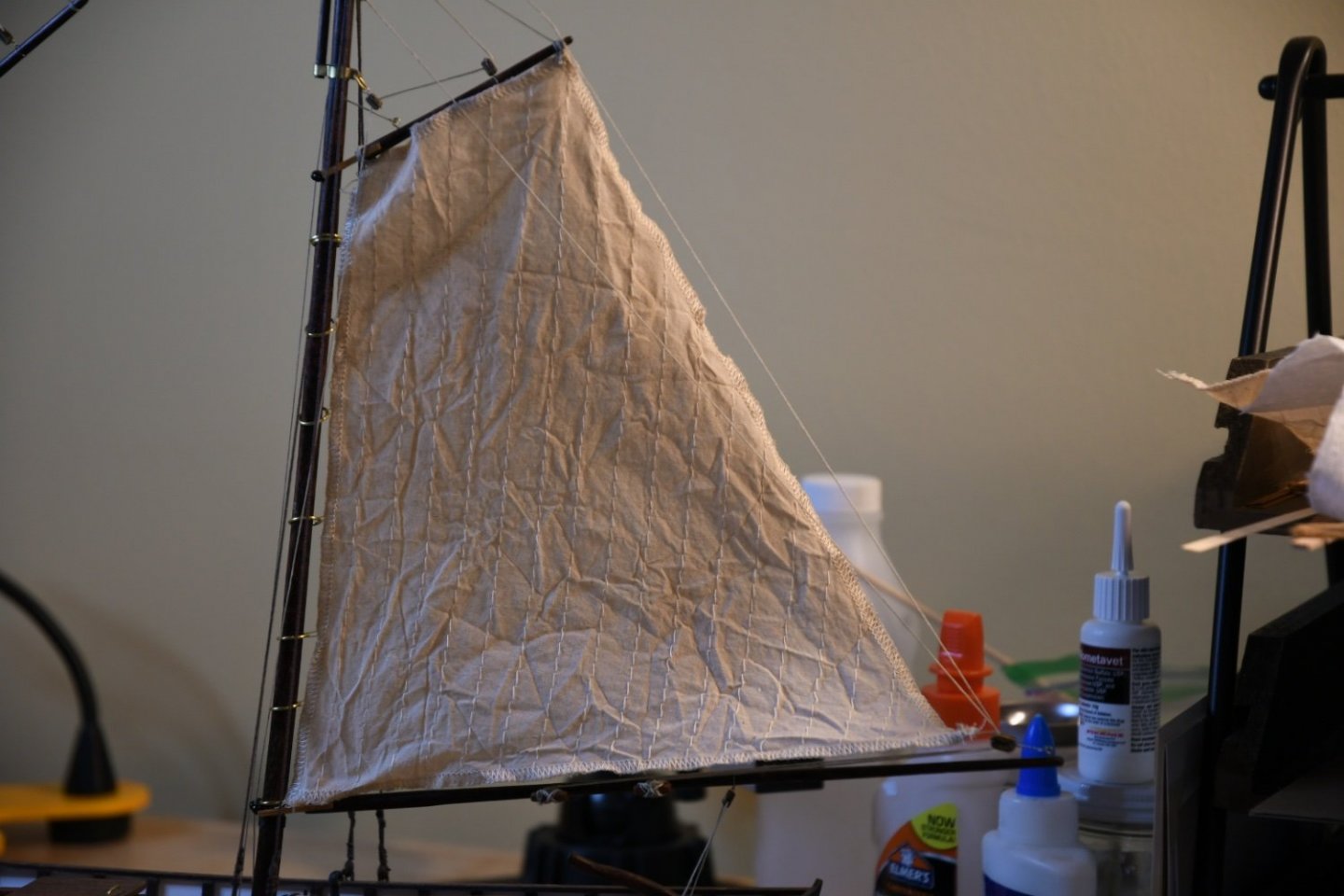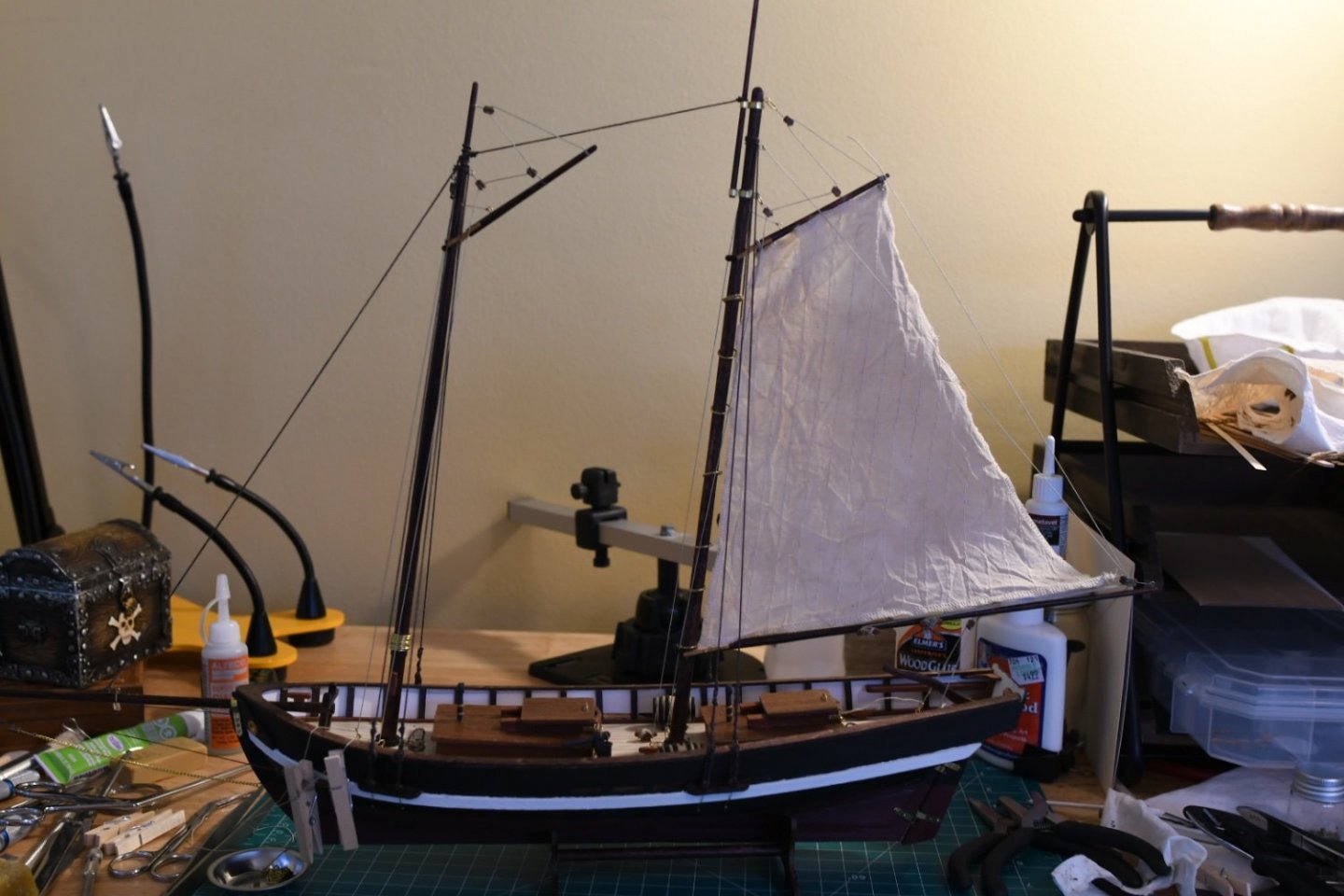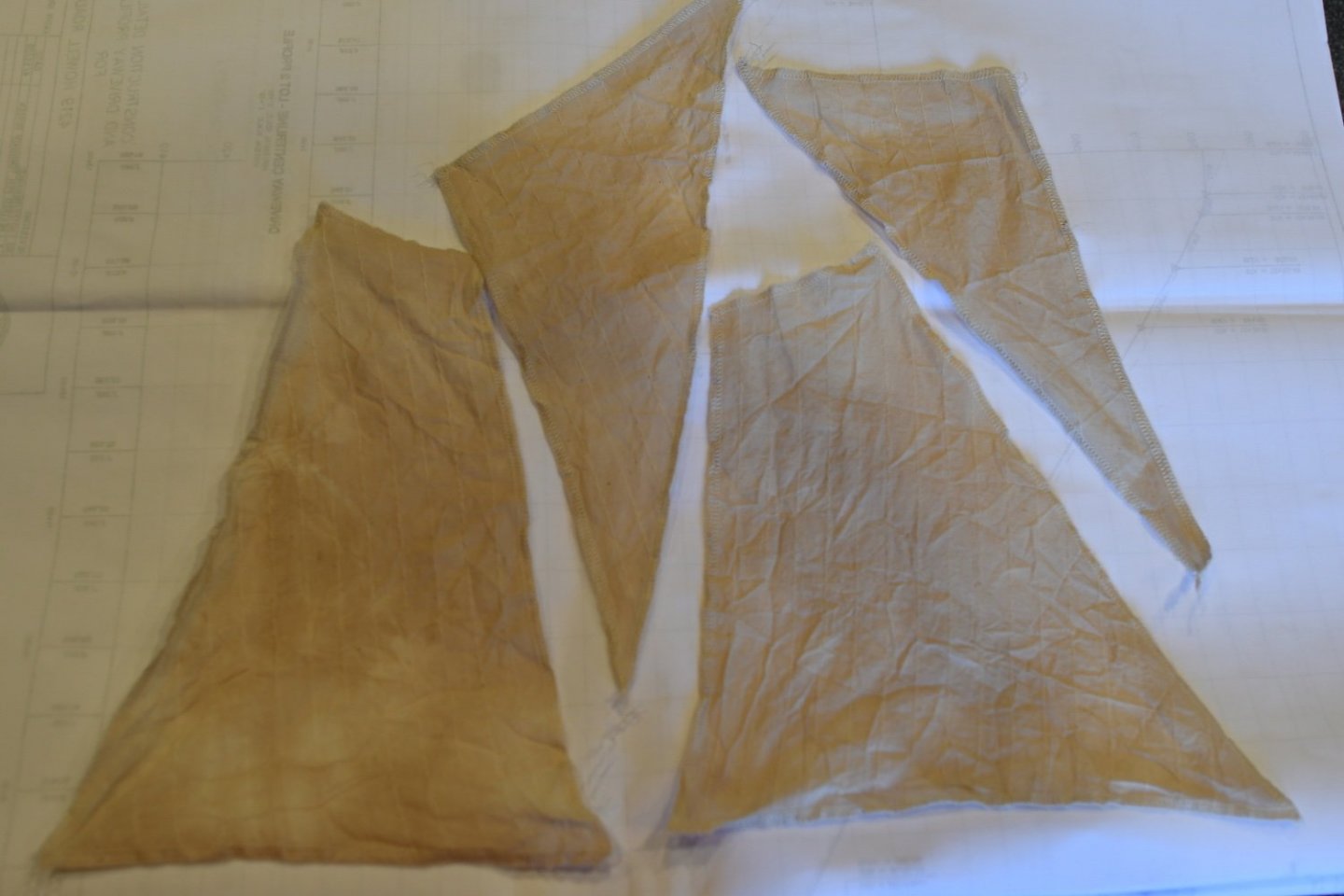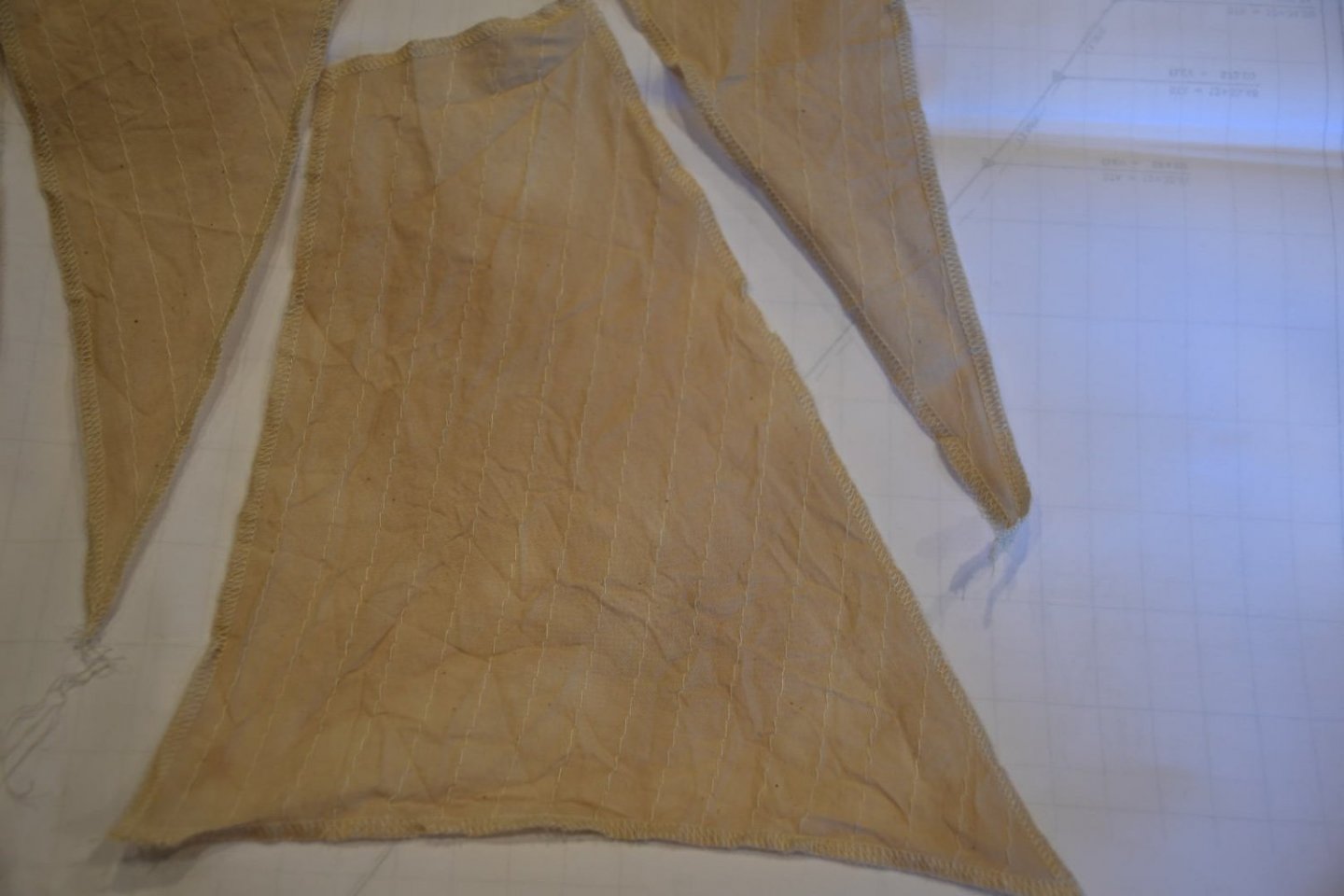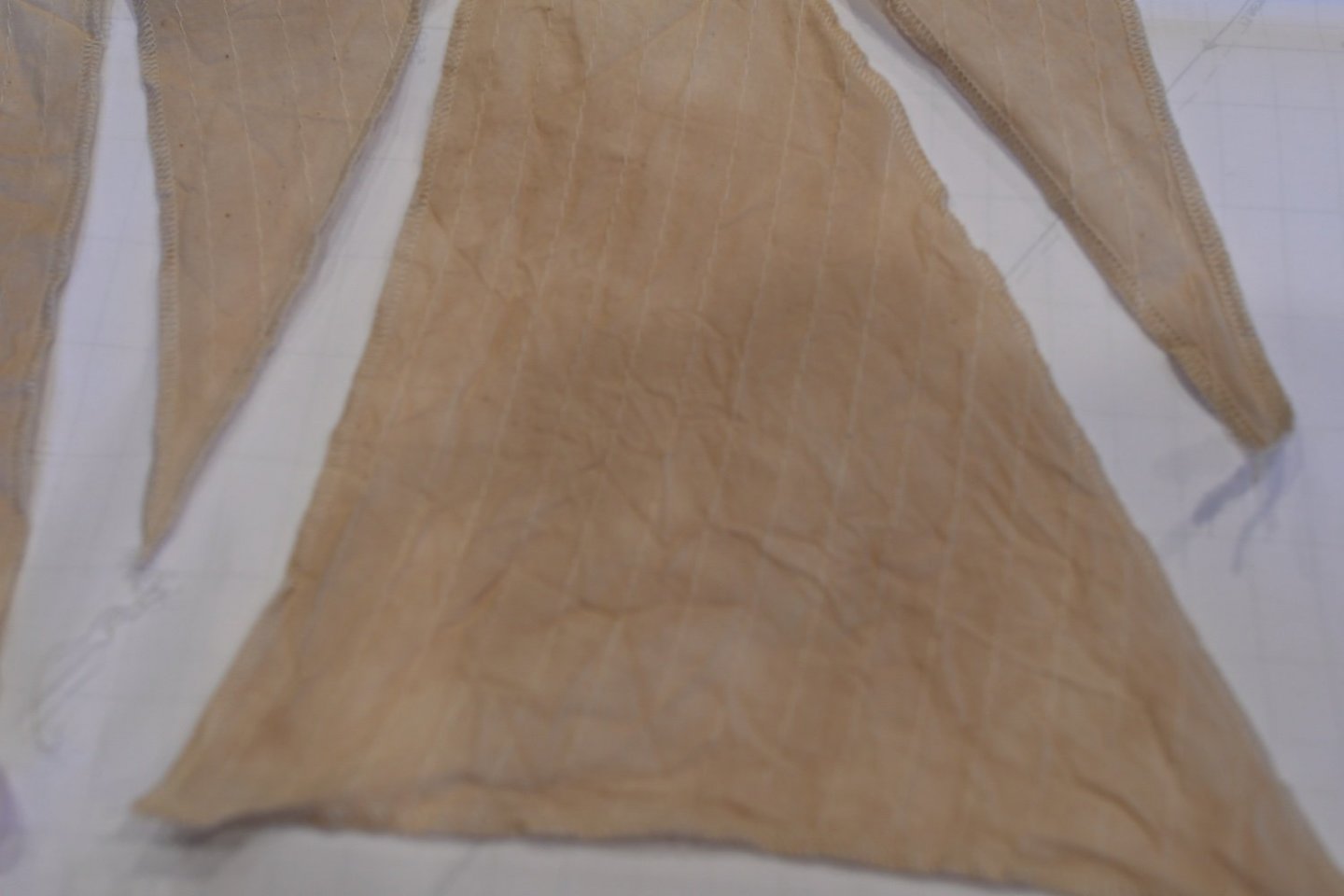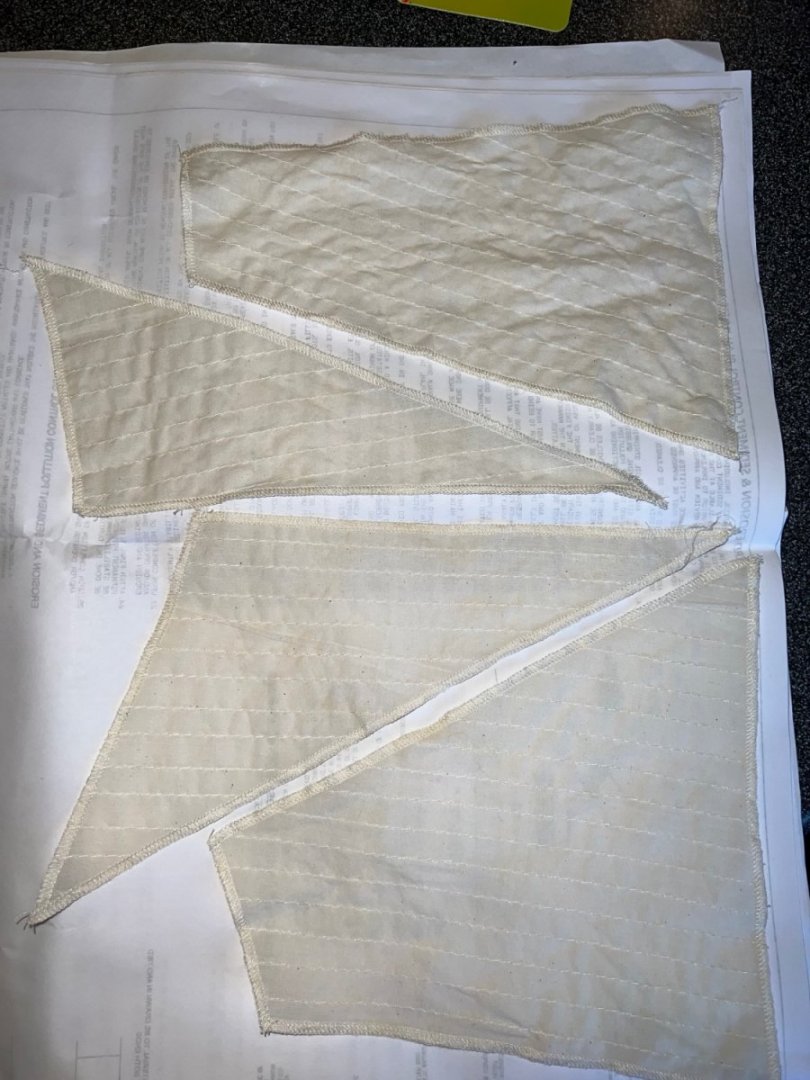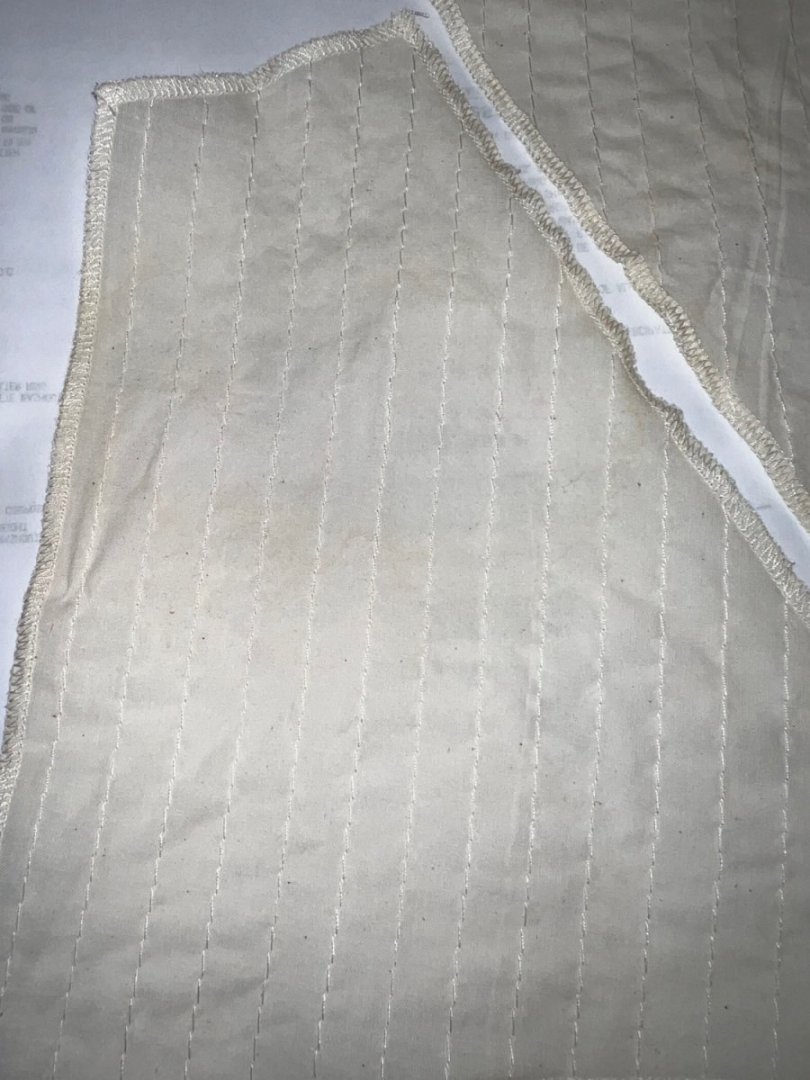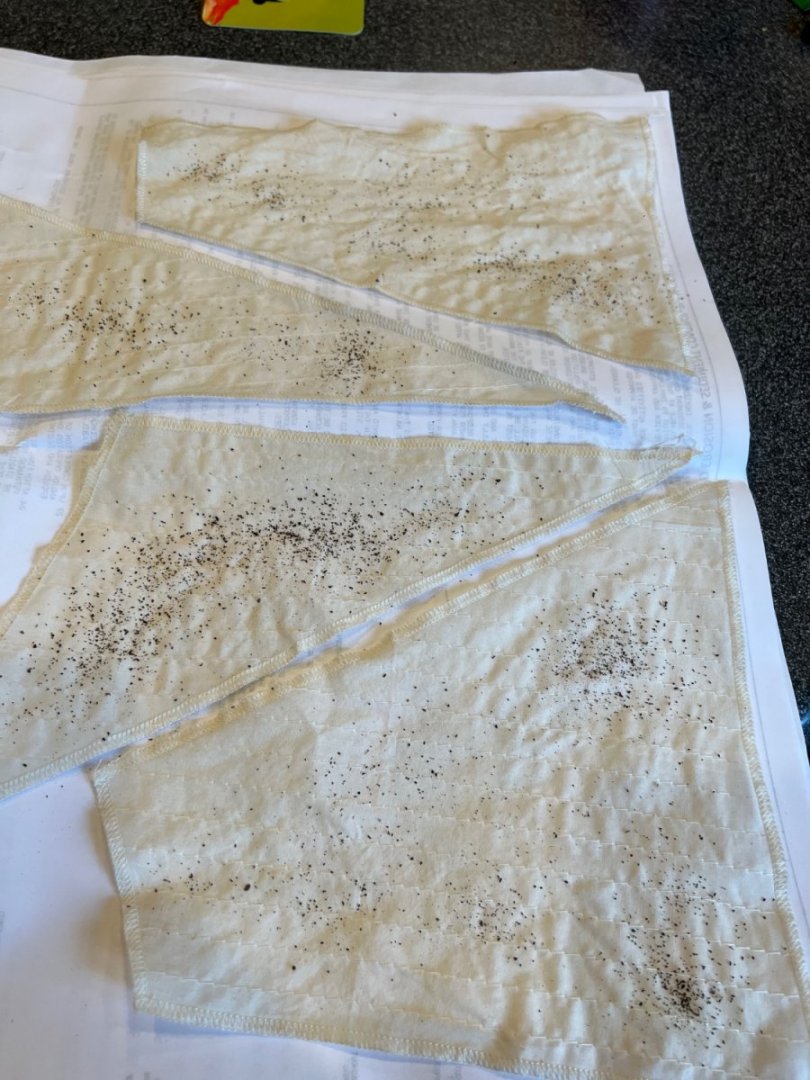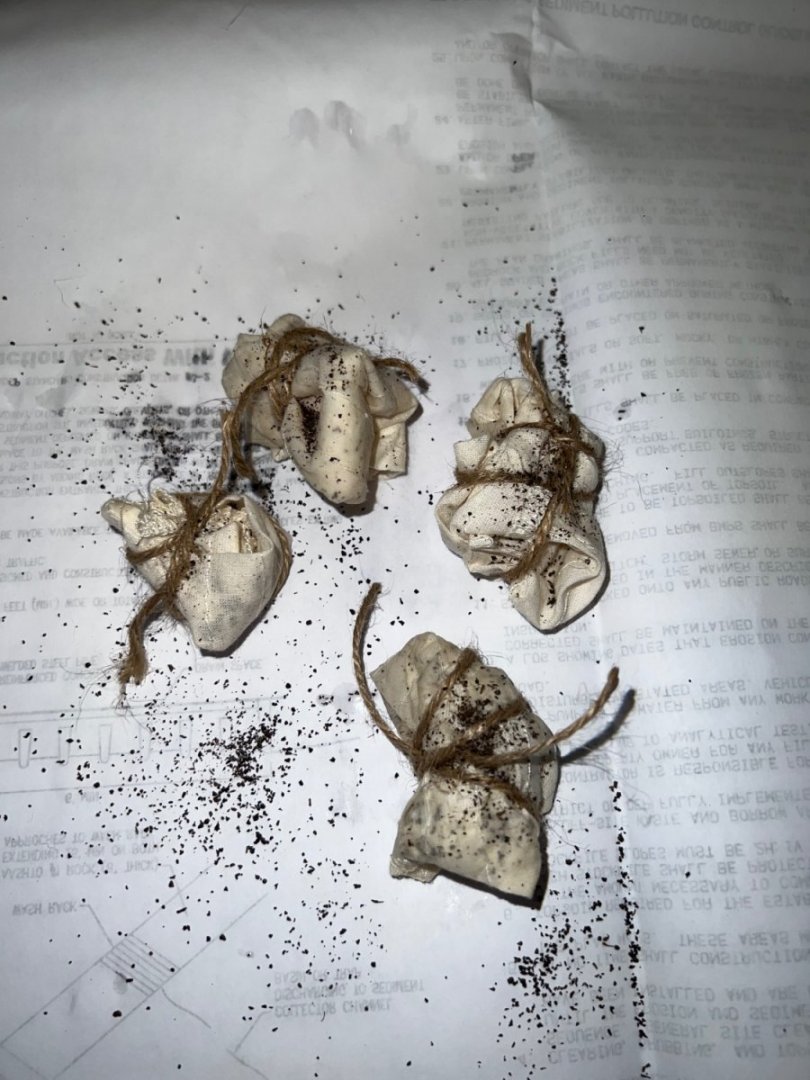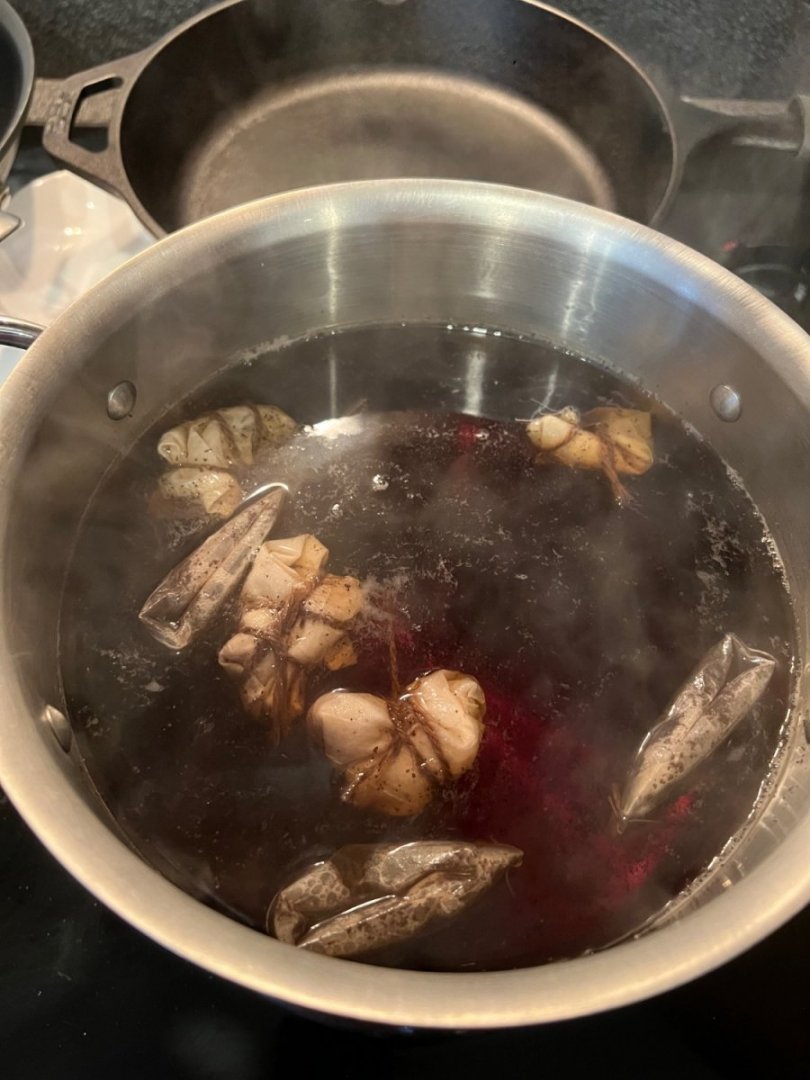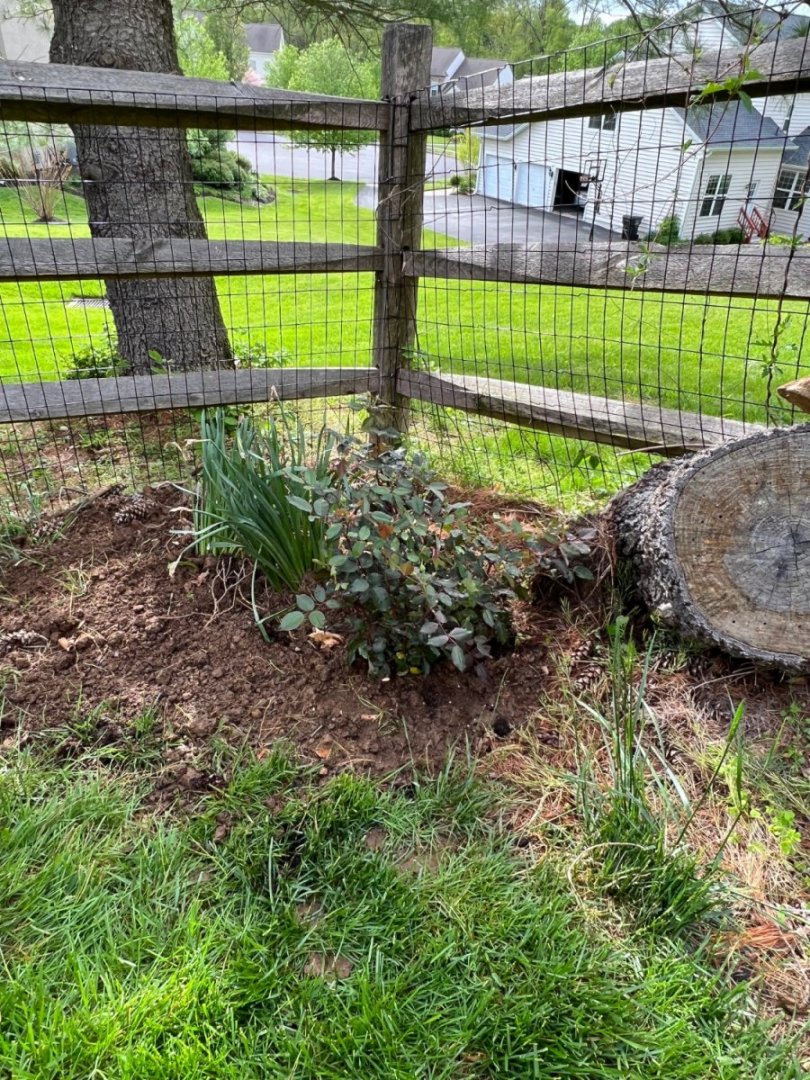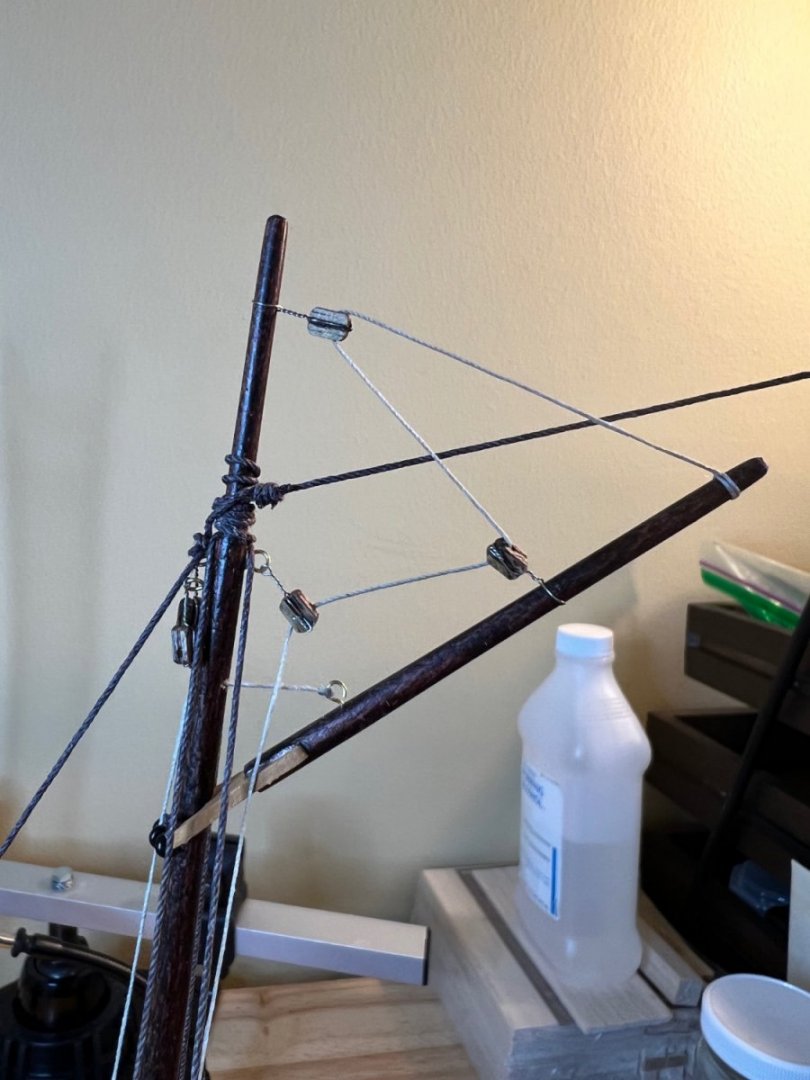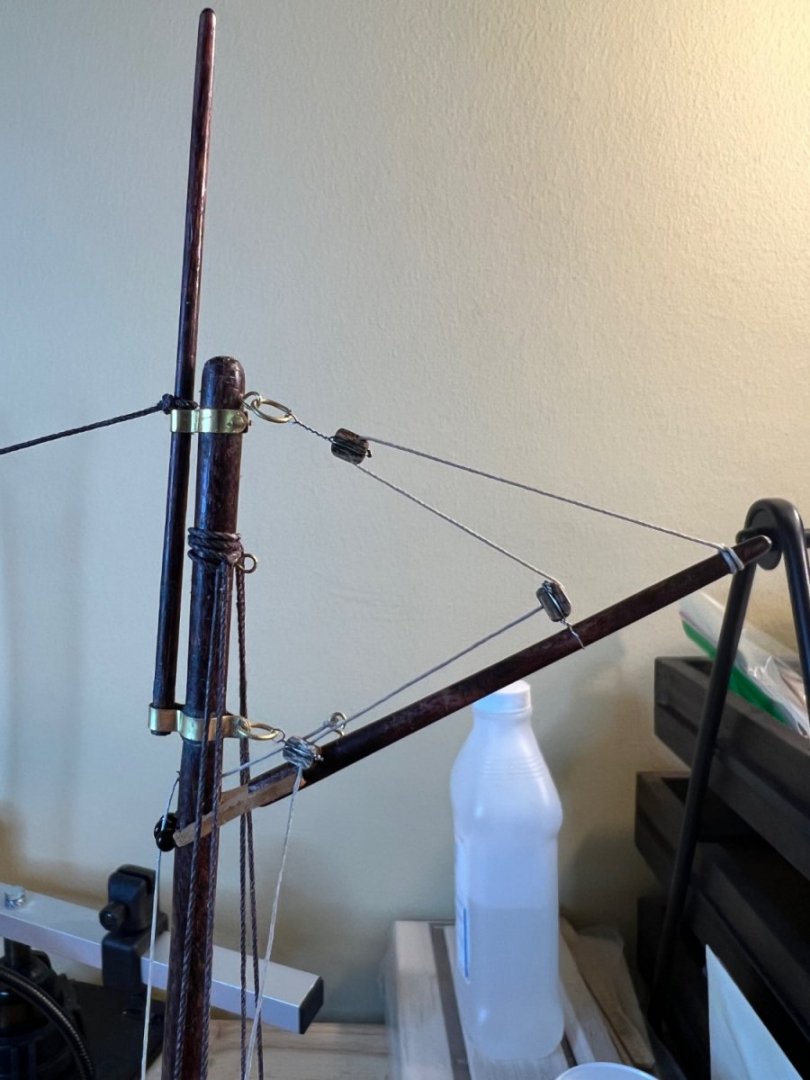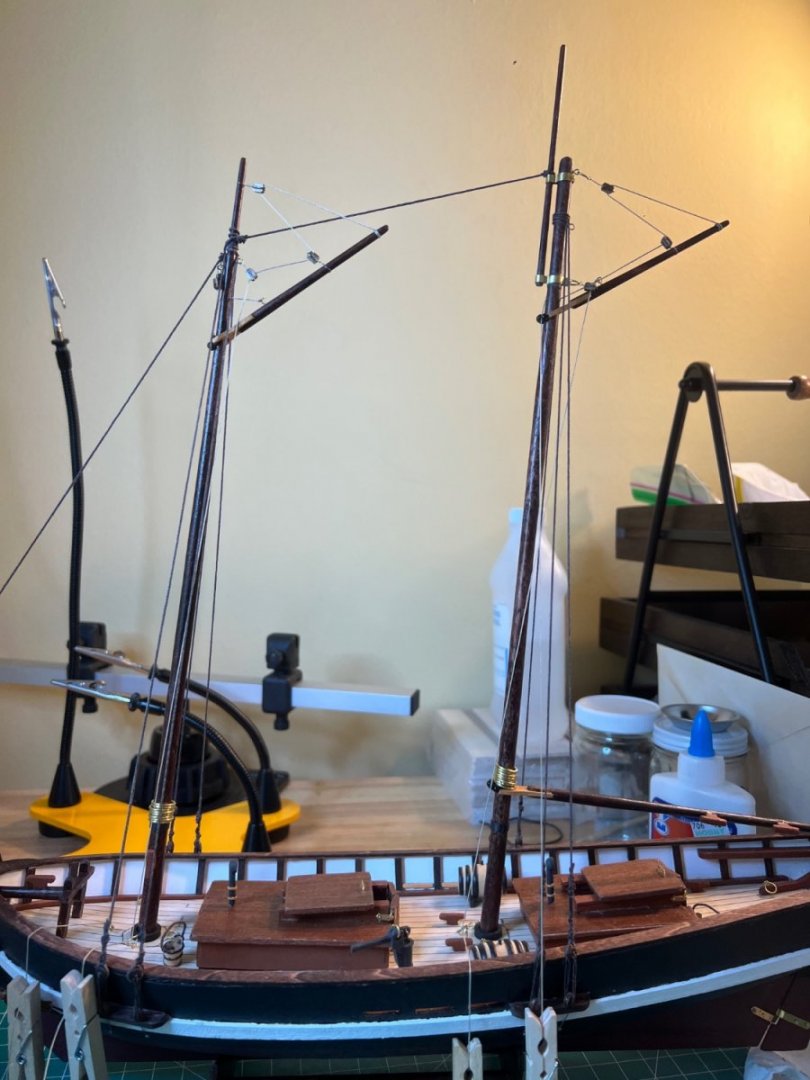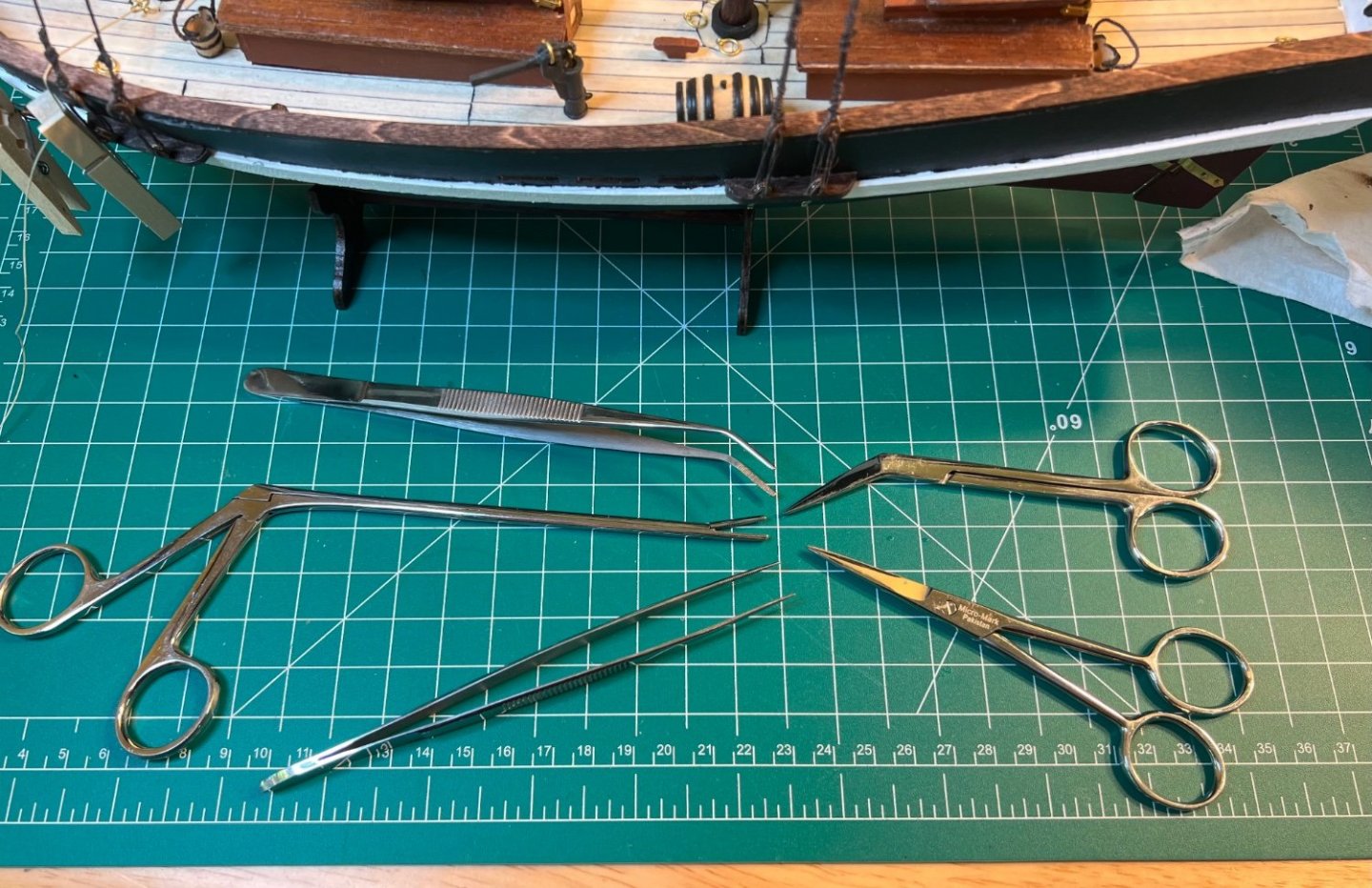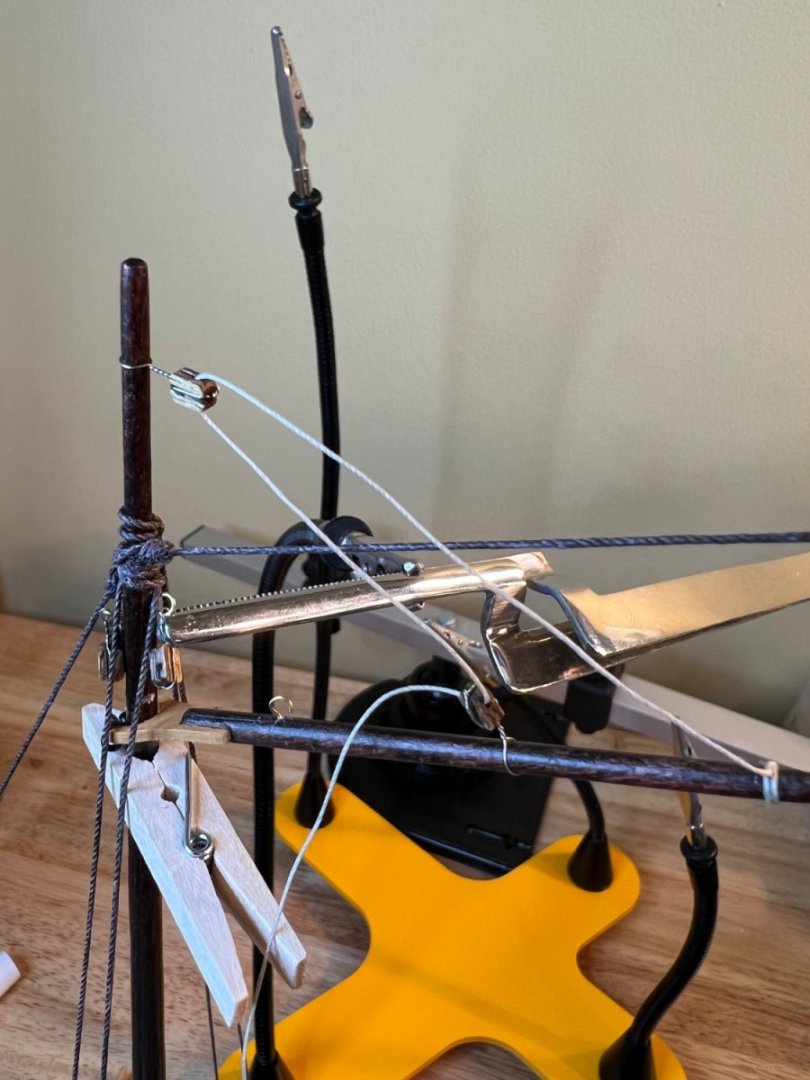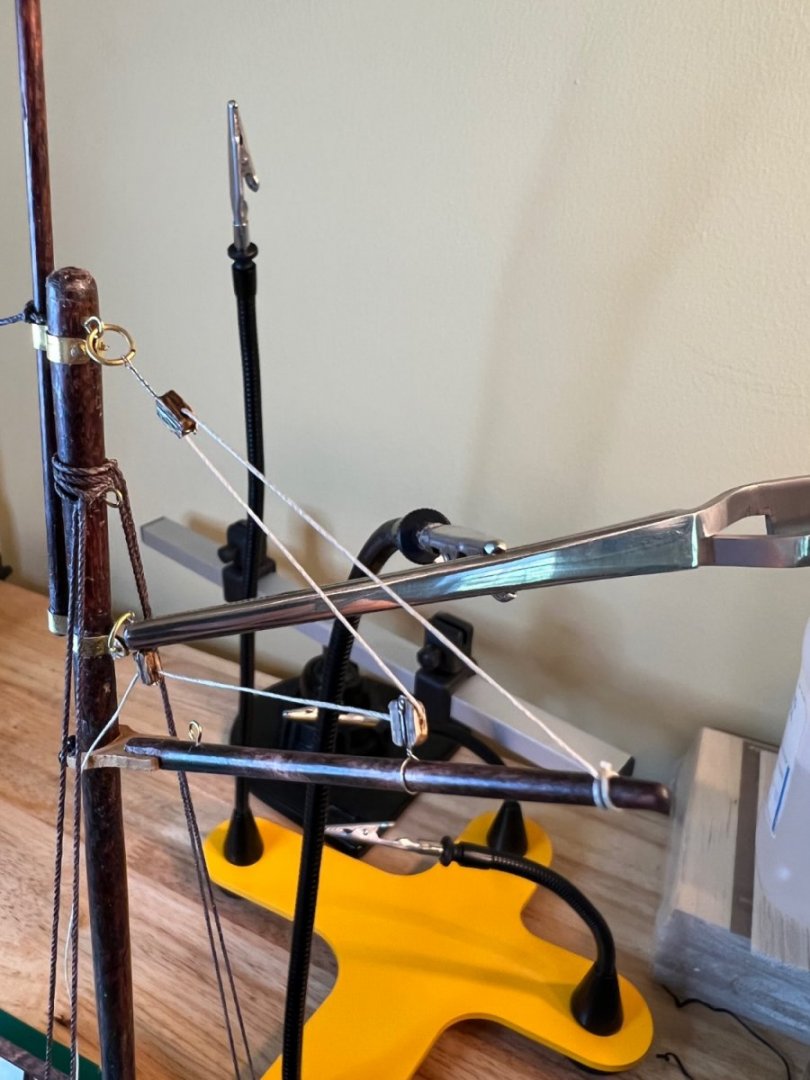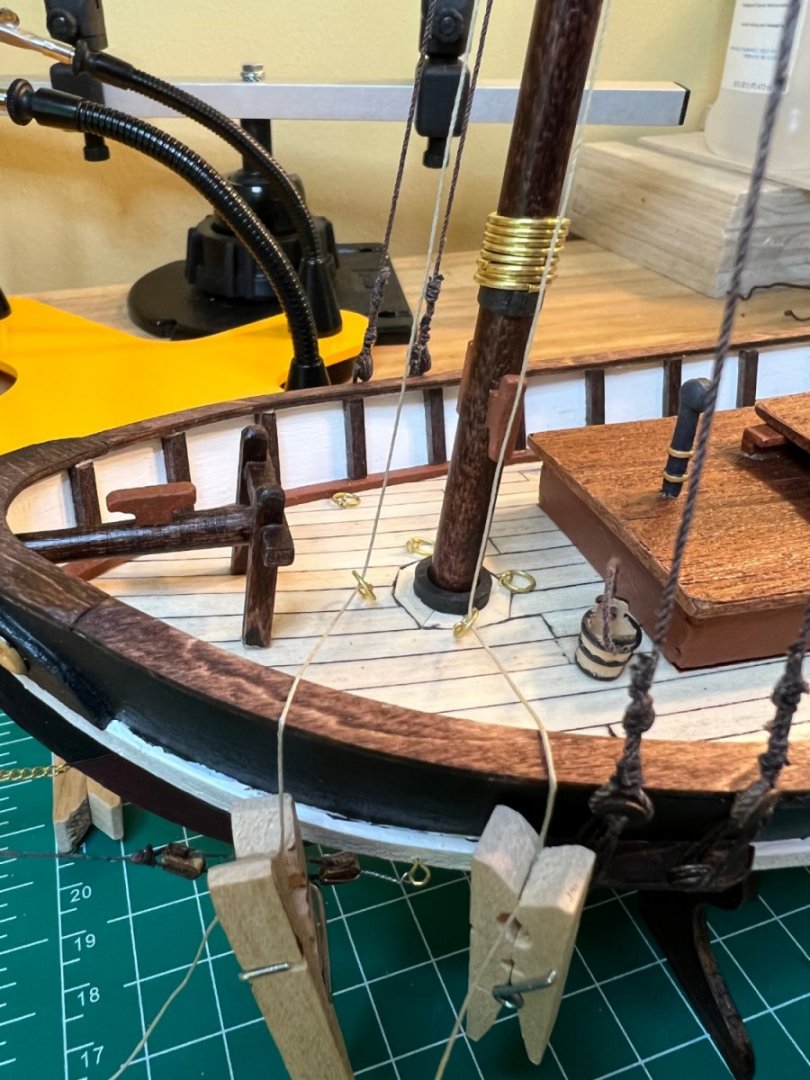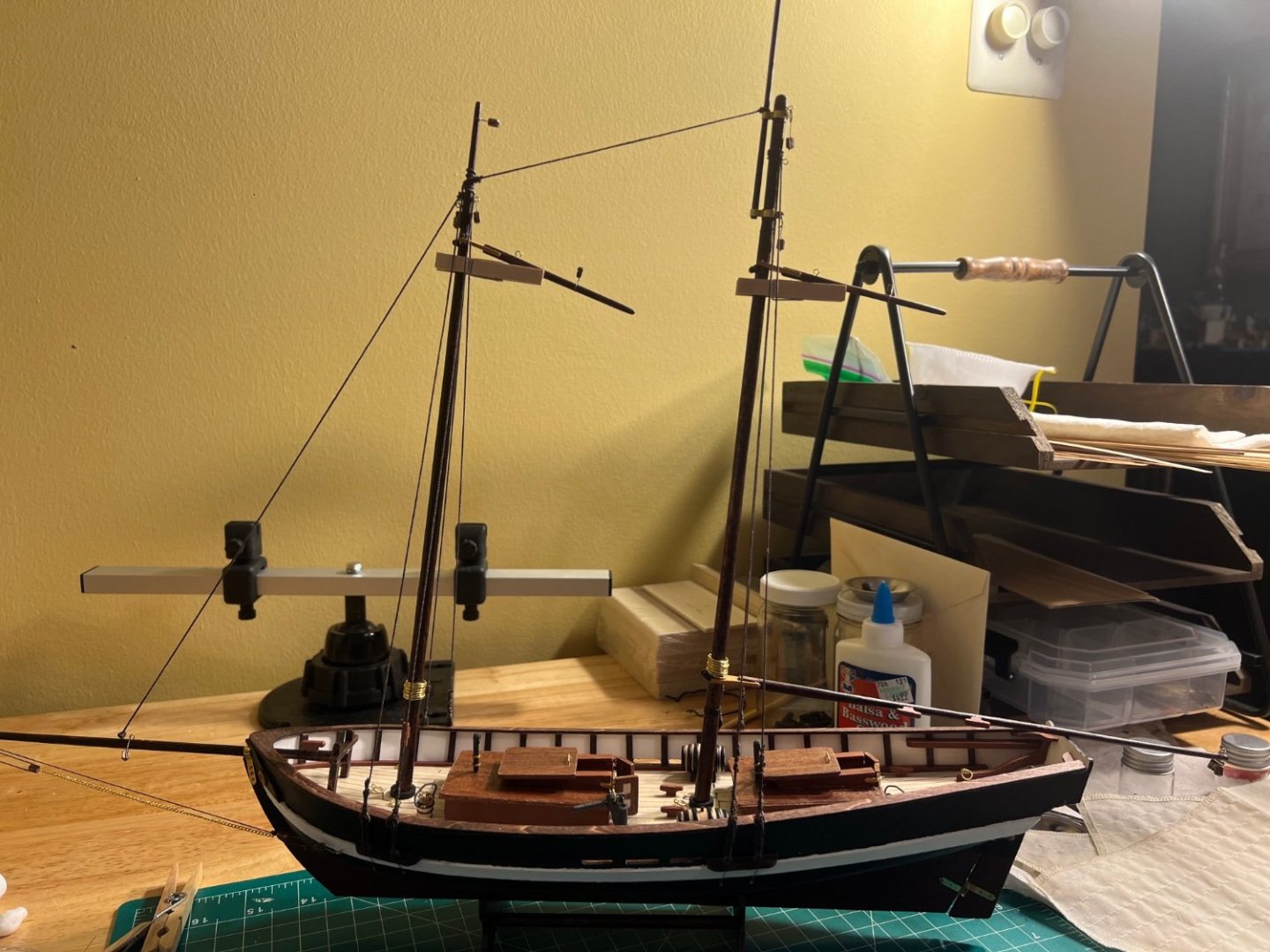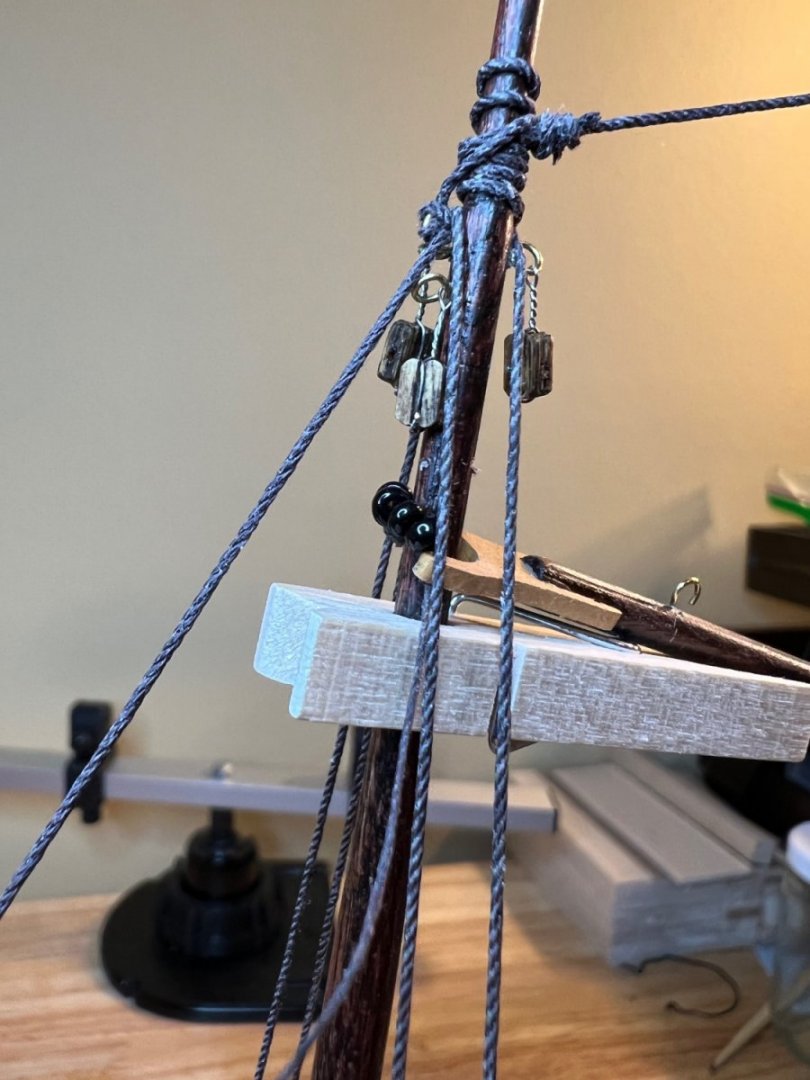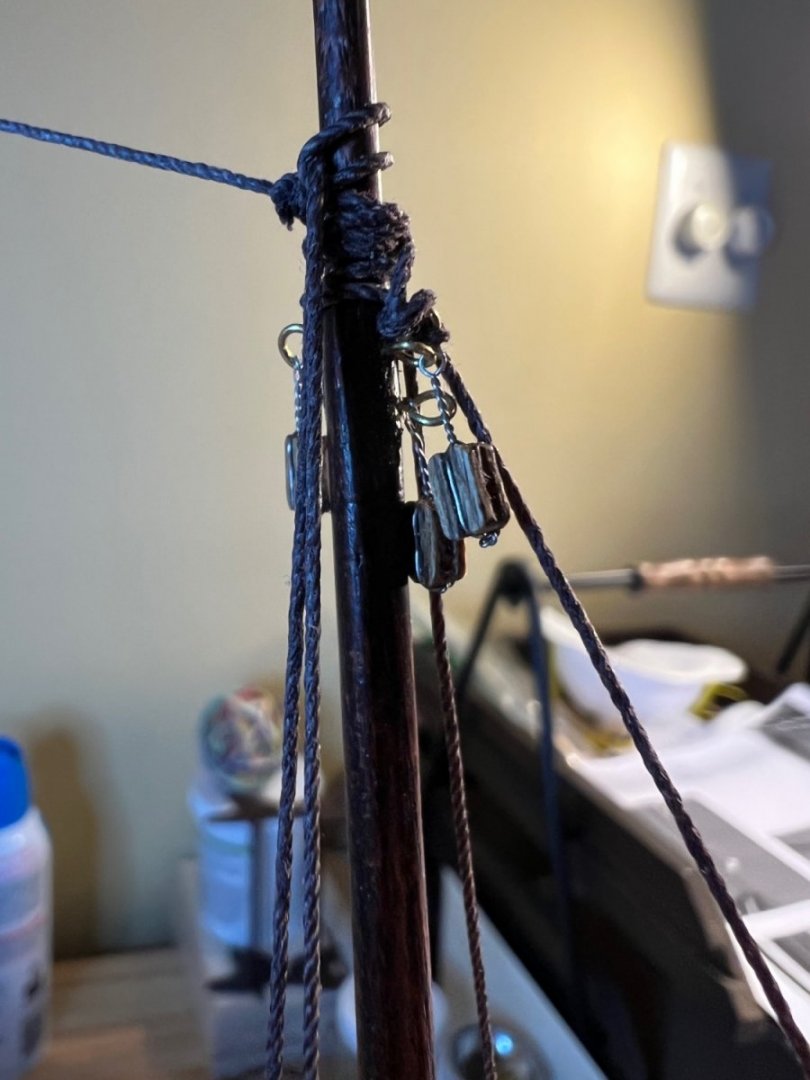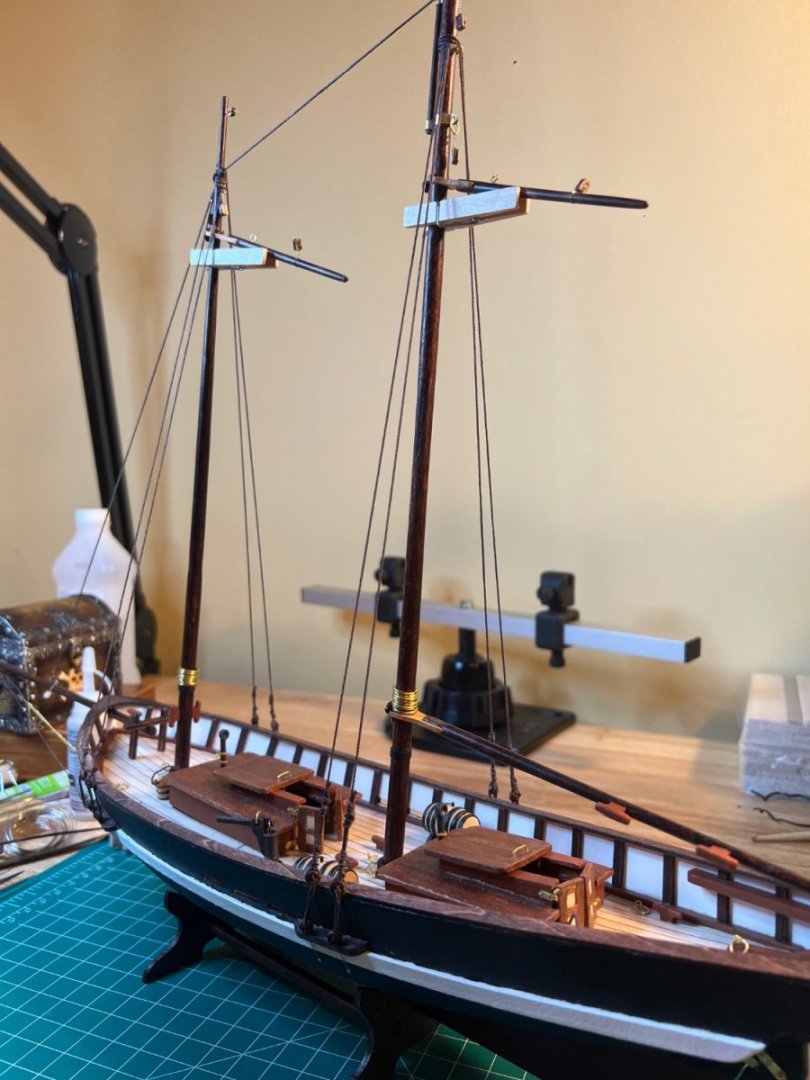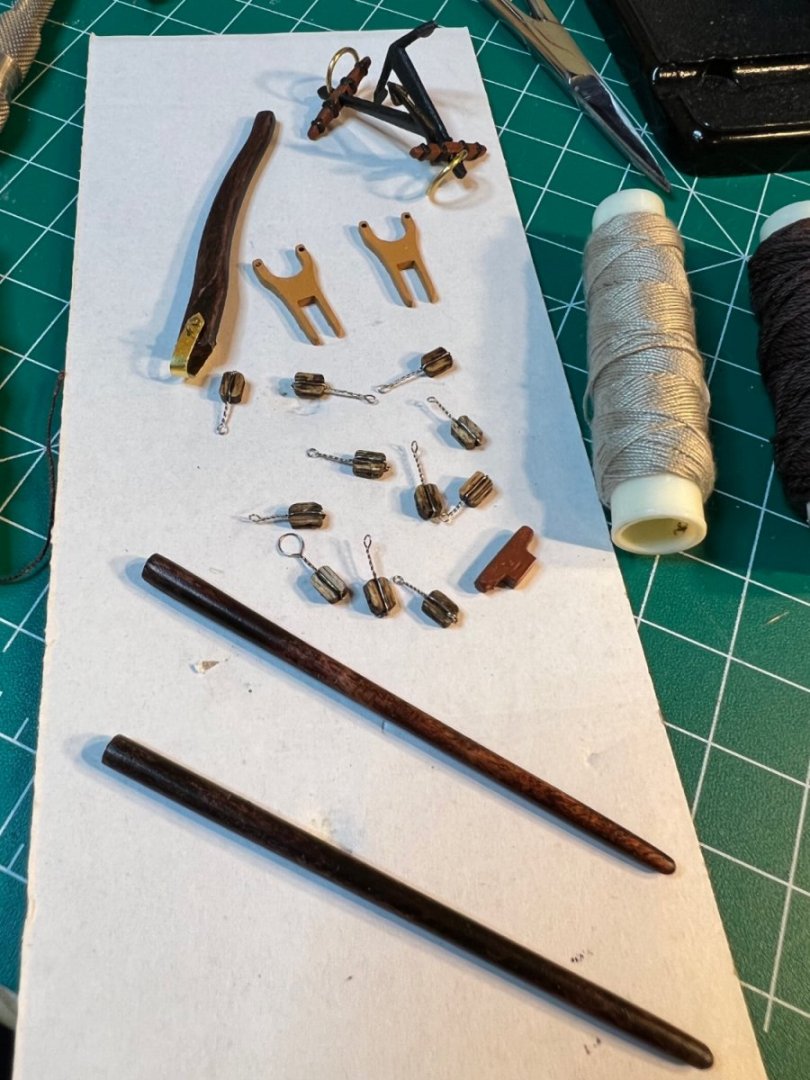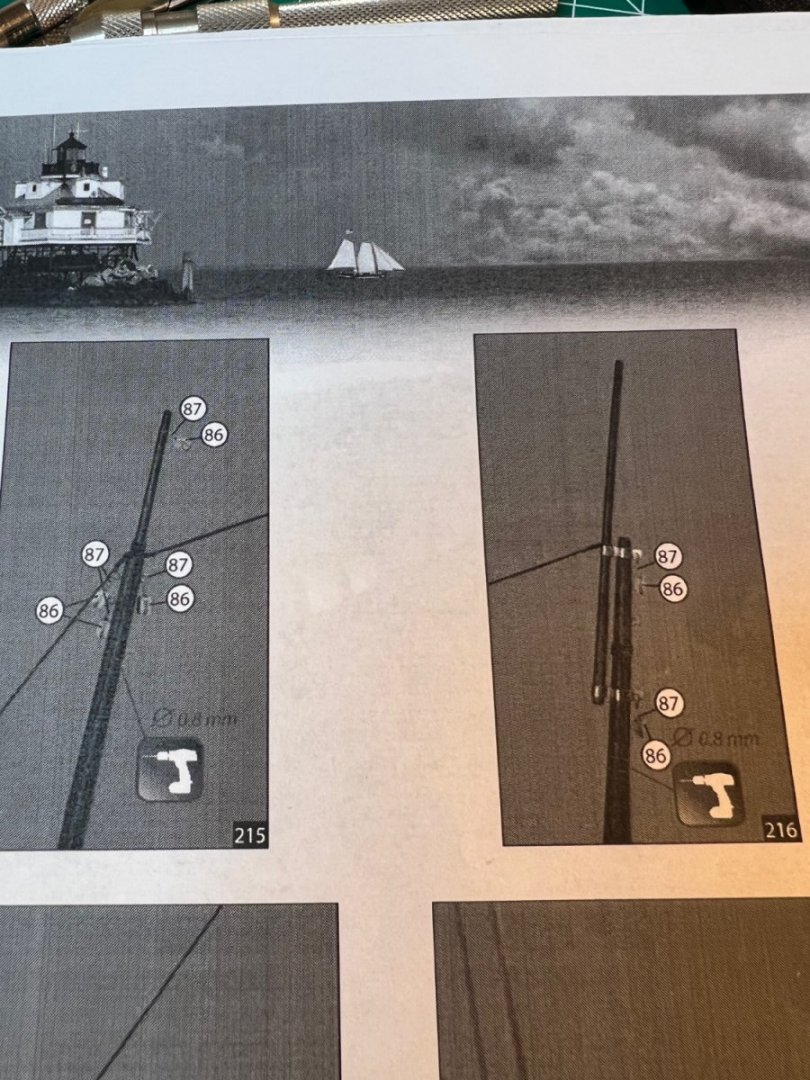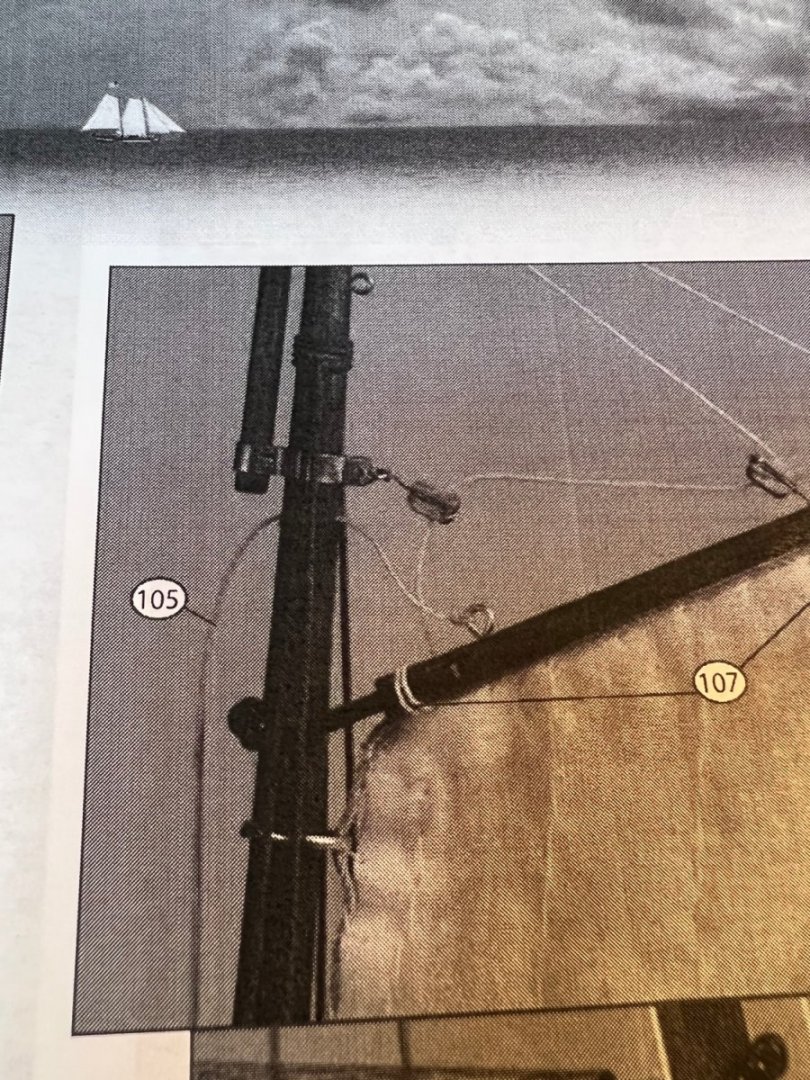
SUBaron
Members-
Posts
197 -
Joined
-
Last visited
Content Type
Profiles
Forums
Gallery
Events
Everything posted by SUBaron
-
Sails and a few other Questions: As I'm rapidly wrapping up the Swift, I have a few questions; 1) Should I have ironed the sails more? After the dying process, they were very wrinkled. I steamed them, but in retrospect, I think a little ironing may have helped. How do you feel they present? 2) Anchors: Does anyone have a good idea of how to stow the anchors? The model shows them hanging. They look a little silly that way - like they fell off (though it gives guests something to tinker with). I think the scale of the ship, coupled with my novice ability limit the type of rack or storage device I can add - but I’ll likely give a good idea a try. 3) My remaining work is mainly tidying up the lines. My question; should I go with rope coils, or hanks, or a combination of both? I wanted to go with both but historical accuracy notwithstanding, the ship design did not include any belaying pins, and the scale and I think my limited ability make me hesitant to insert any (again, I may attempt a good idea). I always felt that rope coils looked very cool, but aren't very practical. They'll stay wet, and get in the sailor's way - good for harbor I suppose, but my ship wouldn't be under full sail in the harbor. Lastly, I wanted to add restraints to the rum (yes, on my ship, they have plenty of water, these are rum barrels 😁) barrels, but can't figure out where to attach the ropes and I don't want to add any eye hooks that people would trip over. I included pics of the anchor and current temporary rope stow, as well as the barrels.
- 111 replies
-
- Swift
- Artesania Latina
-
(and 3 more)
Tagged with:
-
- 111 replies
-
- Swift
- Artesania Latina
-
(and 3 more)
Tagged with:
-
- 111 replies
-
- Swift
- Artesania Latina
-
(and 3 more)
Tagged with:
-
- 111 replies
-
- Swift
- Artesania Latina
-
(and 3 more)
Tagged with:
-
- 111 replies
-
- Swift
- Artesania Latina
-
(and 3 more)
Tagged with:
-
- 111 replies
-
- Swift
- Artesania Latina
-
(and 3 more)
Tagged with:
-
- 111 replies
-
- Swift
- Artesania Latina
-
(and 3 more)
Tagged with:
-
@allanyed @Oldsalt1950 Thanks gents, for your interesting input! I had given some thought to the idea of "aging" the sails. I read a little about pilot boats. They were considered very utilitarian workhorses of their day. As such, even newly launched, they may have been assigned "used" sails. And if not new, their owner would likely not have prioritized new sails, especially given the low range of duty these vessels would have. While I didn't want the sails to look new, I didn't intend for them to be as aged as they came out either (I like how they look, but it's a bit much for this model). I think perhaps a mere dunking to an hour in the tea may have been sufficient. As for the degradation factor. These conversations fascinate me. However, I believe that they are likely better served for the expert craftsman on this site whose end product may well end up sold, in a museum, as part of a serious collection, etc. As for this Swift, it's my first build and I'm not building it for posterity. As an analyst by trade, I'm actually quite fascinated to experience, in real time, my sails, rigging, or anything else, actually begin to degrade over the decades ahead. I'll be quite thrilled in 30 years to see my sails hanging in tatters, as though having been through a hurricane. I mean this comment sincerely, and not as a put down. I have great respect for the expert level of craftsmanship presented on this site, and it fascinates me to learn of the concerns about beeswax, CA glue, high PH levels of tea, etc. I never would've given these things a thought had I not learned about them here (ok, well, the CA thing I was aware of. I use very little of it due to it's limitations in handling torque). I find that many of these questions lead to more questions that can't be answered without actual scientific study. For example, does decaf tea change the PH level - what about adding salt to the solution, then rinsing? How does household humidity effect the process...the annual cycle of AC and Heat.. sunlight...cigar smoke - human oils (from handling - as every visitor has wanted to do)? All of these things can effect the degradation process. And some, possibly can counteract it. It all makes for interesting conversation (though unfortunately, not to anyone in my house 😁) Cheers!
- 111 replies
-
- Swift
- Artesania Latina
-
(and 3 more)
Tagged with:
-
I’m happy with the results. I steamed the bulk of the wrinkles out, but may do some spot ironing to remove a few more.
- 111 replies
-
- Swift
- Artesania Latina
-
(and 3 more)
Tagged with:
-
Slowly wobbling back to the helm. After viewing some period sails, and online techniques, I decided to dye the sails with a black tea process. This included sprinkling some tea directly onto the sails, and then bundling them to result in random patterns of dye (referred to as "whimsy"). Hopefully, the areas with creases from the bundling will result in more pronounced coloring. Once bundled, into the tea they went for an hour. I will leave them to soak overnight, rinse them tomorrow, give them a very diluted vinegar/water bath to help the dye set, then rinse them heavily again.
- 111 replies
-
- Swift
- Artesania Latina
-
(and 3 more)
Tagged with:
-
So close to the finish line…and my back went out. Couldn’t refuse a day of planting with my mom, but a stubborn root-impacted hole I dug for the Coral Knock Out Rose bush did me in. I can barely get out of bed. Getting dressed is an adventure - even with enough meds to knock out a horse, and I walk around like Quasimodo. I shall return! The 1st pic was the culprit that did me in. This will give me more time to ponder the dying, or not, of my sails. I may experiment with using the coral rose petals as a dye.
- 111 replies
-
- Swift
- Artesania Latina
-
(and 3 more)
Tagged with:
-
Took some time today to steam out the folds in my 4 sails. I used an old Black + Decker “Steam N’Go” portable garment steamer. It worked very well - no more folds. I thought about dying the sails but l’m happy with the off white/cream color. The ship will look new when completed, so why would it be outfitted with old dirty sails? I’m not sure about adding tell-tales.
- 111 replies
-
- Swift
- Artesania Latina
-
(and 3 more)
Tagged with:
-
Thanks @Oldsalt1950 - much appreciated!
- 111 replies
-
- Swift
- Artesania Latina
-
(and 3 more)
Tagged with:
-
- 111 replies
-
- Swift
- Artesania Latina
-
(and 3 more)
Tagged with:
-
The tools look like they were lifted from a surgeon’s kit. It’s interesting that you don’t need them at all for 90% of the build, then they are suddenly indispensable.
- 111 replies
-
- Swift
- Artesania Latina
-
(and 3 more)
Tagged with:
-
Rigging the yards may be a little easier with the wire stripped blocks - they’re relatively easy to clamp when rigging the Halyards. For the Halyards, I used a method I learned from several MS blogs - dip the Halyard in a bit of CA, then cut it at an angle and it feeds easily into the small block holes.
- 111 replies
-
- Swift
- Artesania Latina
-
(and 3 more)
Tagged with:
-
Thanks Keith - I appreciate that. It’s been a fun journey with enough challenges to keep it interesting, but not overwhelming - so far. I still have the sails to complete. Prior to attaching the Shrouds, I planned for the sail attachment, so I gave them a dry run. That ended in me having to move back the fore staysail blocks on the bowsprit, and move up the top spars to fit the main and foresails. I suspect I missed something but will land that fish when it strikes.
- 111 replies
-
- Swift
- Artesania Latina
-
(and 3 more)
Tagged with:
-
Hang in there Dave! Think outside the box and you may yet find a solution. I always see roadblocks like this as a perfect opportunity to invest in new tools 😆
- 362 replies
-
- Amati
- Lady Nelson
-
(and 2 more)
Tagged with:
-
I had some minor difficulty attaching the beads/bearings to the top spars. I realized after the fact they they will actually be load bearing for the sails and the best application of the bearings was feeding the line from the top, with the bearings beneath. This was the opposite of the boom configuration, which carries an inverse load.
- 111 replies
-
- Swift
- Artesania Latina
-
(and 3 more)
Tagged with:
-
- 111 replies
-
- Swift
- Artesania Latina
-
(and 3 more)
Tagged with:
-
- 111 replies
-
- Swift
- Artesania Latina
-
(and 3 more)
Tagged with:
-
I have a 3 month track record now of 100% of the time I drop something, it never lands on my leg. I end up slowly rolling my chair back and hoping not to hear a crunch signaling the destruction of 2 hours worth of work 😂 . I’ve only actually lost 2 relatively inconsequential parts. 1 piece had to be surgically extracted with tweezers as it teetered precipitously on the edge of the register void.
- 111 replies
-
- Swift
- Artesania Latina
-
(and 3 more)
Tagged with:
-
Next up- 12 wire stropped blocks for attachment at various locations. I’m skeptical about the location of 2 rigging directions that call for the line to go directly from the spar, through the main and fore masts (see pictures below). I would think that would never be done due to the high friction on the load points. Not to mention weakening the mast structure.
- 111 replies
-
- Swift
- Artesania Latina
-
(and 3 more)
Tagged with:
About us
Modelshipworld - Advancing Ship Modeling through Research
SSL Secured
Your security is important for us so this Website is SSL-Secured
NRG Mailing Address
Nautical Research Guild
237 South Lincoln Street
Westmont IL, 60559-1917
Model Ship World ® and the MSW logo are Registered Trademarks, and belong to the Nautical Research Guild (United States Patent and Trademark Office: No. 6,929,264 & No. 6,929,274, registered Dec. 20, 2022)
Helpful Links
About the NRG
If you enjoy building ship models that are historically accurate as well as beautiful, then The Nautical Research Guild (NRG) is just right for you.
The Guild is a non-profit educational organization whose mission is to “Advance Ship Modeling Through Research”. We provide support to our members in their efforts to raise the quality of their model ships.
The Nautical Research Guild has published our world-renowned quarterly magazine, The Nautical Research Journal, since 1955. The pages of the Journal are full of articles by accomplished ship modelers who show you how they create those exquisite details on their models, and by maritime historians who show you the correct details to build. The Journal is available in both print and digital editions. Go to the NRG web site (www.thenrg.org) to download a complimentary digital copy of the Journal. The NRG also publishes plan sets, books and compilations of back issues of the Journal and the former Ships in Scale and Model Ship Builder magazines.

